
7 May 2025: Heritage Plaque for Harold Le Druillenec
The happy news has reached the Frank Falla Archive that Harold Le Druillenec, who is one of the more prominent people on this website, has been honoured in Jersey with a special plaque erected by Jersey Heritage. It was unveiled by Lieutenant-Governor Vice Admiral Jerry Kyd in a special ceremony at St John’s School, where Le Druillenec was headmaster from 1949-1971. Le Druillenec’s grandchildren Peter and Linda travelled from Australia for the occasion.
Harold Le Druillenec is perhaps Jersey’s best-known survivor of Nazism from the time of the Occupation. He helped his sister, Louisa Gould, to shelter a Russian slave worker. For this offence, she was deported along with Harold and her housekeeper, Berthe Pitolet. They were deported on the last day of June 1944, among the very last group of Channel Islanders to be deported before the allied liberation of France made deportations impossible. They were kept in a number of prisons and, while in Rennes, the prison was bombed and Pitolet escaped but neither Harold or Louisa were able to. While Louisa was sent on to Ravensbrueck Concentration Camp, where she was murdered, Harold was sent to a number of camps including Neuengamme, Alter Banterweg and Bergen-Belsen. He was the only British citizen found by liberators and he survived to testify at a number of war crimes trials. Although he struggled with PTSD after the war and had a breakdown after he returned to teaching, he took a break and then returned to his job.
The news article on the BBC can be read here.

25 and 26 July 2024: Stolpersteine laid in the Channel Islands
On 25 and 26 July 2024, celebrated German artist Gunter Demnig came to the Channel Islands to lay a total of 35 Stolpersteine. Demnig has previously laid over 106,000 Stolpersteine across mainland Europe in 31 different countries. Stolpersteine (‘stumble stones’) are memory stones laid into the ground outside the last home of victims and survivors of Nazism. Stolpersteine are so called not because you stumble on them (they are flush with the pavement); rather because you stumble across them and ‘stumble with your head and your heart’, as Demnig puts it. He came to Guernsey and Jersey at the invitation of Dr Gilly Carr who worked with Chris Addy of Jersey Heritage and Helen Glencross of Guernsey Museums. Stolpersteine are a form of remembrance which requires a greater effort or commitment to remember on behalf of the viewer as you have to bend down to see them and read the text.
The list of those honoured in Guernsey can be found here; in Jersey, the list can be found here. Various news agencies and organisations reported on the event, including the BBC, the Jersey Evening Post and Guernsey Press, the Bailiwick Express and Channel 103. The story of every person recognised with a memorial stone can be found here on the Frank Falla Archive.
The choice of recipients was not an easy one, but in Guernsey it was decided to lay Stolpersteine to the Guernsey 8 who did not return from Nazi prisons and camps after being deported for acts of protest, defiance and resistance. Also recognised were the three Jewish women who were deported from Guernsey to France in April 1942, from where they were rounded up and sent to Auschwitz three months later, where they were murdered. Of the final four, all of which were laid for survivors of Nazism, Frank Falla received a stone, as did Elisabet Duquemin nee Fink, a Viennese-born Jewish woman who had arrived in Guernsey in the late 1930s and was deported to Compiegne and Biberach civilian internment camps on account of being a British Jew. The two others chosen for a stone were Frank Tuck and Kingston Bailey, two of the 16 policemen deported in 1942 to a series of Nazi prisons, forced labour camps and concentration camps. As none of the policemen had their convictions quashed after the war and none have ever received an apology, they were given a Stolpersteine as a sign of recognition of their suffering.
In Jersey, the 20 stones were all laid for those who survived Nazism. As the Jersey 21 have been an established group of people recognised since 1996, the people honoured with this round of Stolpersteine widens the list of those acknowledged in Jersey for what they suffered at the hands of the Nazis. This included two Jews in hiding (Hedy Bercu and Erica Richardson), three Jews who faced persecution in Jersey (Nathan Davidson, Victor Emmanuel and Hyam Goldman), Esther Lloyd and Ruby Still who were deported to Compiegne and Biberach civilian internment camps as British Jews; Jewish man John Finkelstein who survived Buchenwald and the Terezin Ghetto; Gordon Prigent and Walter Gallichan who were forced labourers at Lager Norderney in Alderney; Anthony Faramus, who survived Buchenwald and Mauthausen concentration camps, Harold Le Druillenec, who was in a number of concentration camps including Bergen Belsen, and who went on to testify at war crimes trials; Michael Ginns, deported to Biberach and Wurzach camps and who did so much to promote peace and reconciliation; Emile Du Bois, survivor of Buchenwald; Peter Hassall, who was sent to a series of camps after being caught attempting to escape; the artists and resistance duo Susanne Malherbe and Lucy Schwob; Emma Marshall, who endured many forced labour camps; local resistance hero and guardian of memory Joe Miere, and Jean Marie Rossi, who endured camps after being deported for being Italian.
The Stolpersteine laying across Guernsey and Jersey were emotional and meaningful events, highly emotional and symbolic for families, and two days of solidarity as many moved with families from address to address to watch the stone laying. All involved were proud to have brought Gunter Demnig and his Stolpersteine to the Channel Islands, and it is hoped that more of these beautiful memorials can be laid in future years.
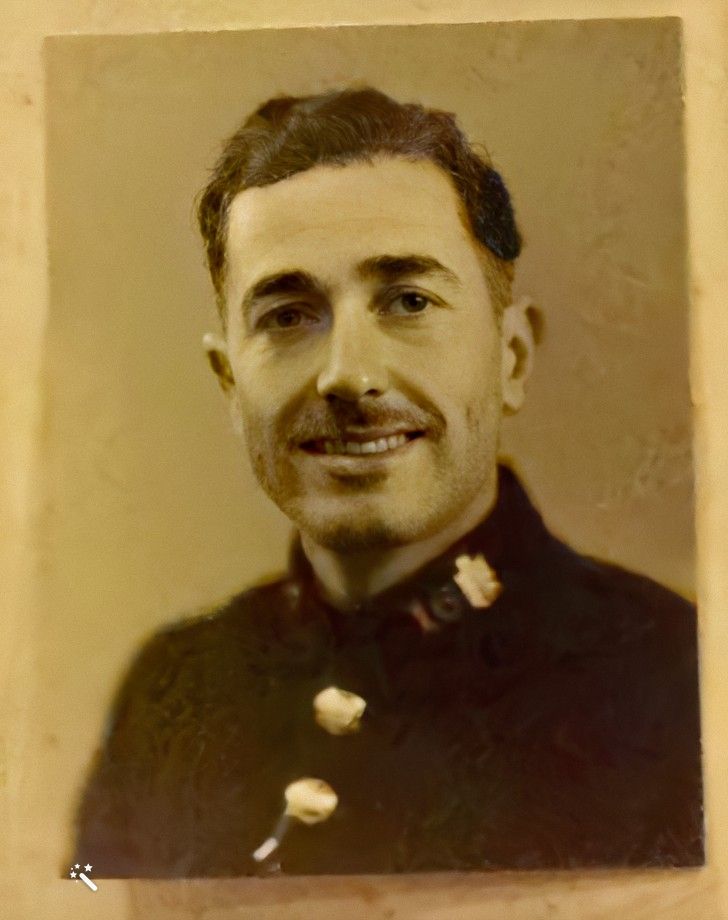
Today, the story of Guernsey’s Frank Tuck and his family’s appeal for an apology has been made the focus on a Channel TV news item and short film. Frank Tuck and his colleagues in the Guernsey police force were deported to Nazi prisons, labour camps and concentration camps after they were tried by both the German court and the Royal Court for alleged thefts of food. The tragedy is that the Royal Court was manipulated by the Germans and acted as a collaborationist court in this regard – something that has never been admitted or apologised for, even though one of Frank Tuck’s colleagues was murdered by a guard.
Frank Tuck’s daughter, Angela, and grand-daughter, Clare, are fighting for an apology, and were filmed by Channel TV earlier this summer to share his story and their appeal to the States of Guernsey for an apology. They were joined by University of Cambridge academic Dr Gilly Carr, a specialist in this field. Clare also travelled to Guernsey for filming, where she spoke to Deputy Jonathan Le Tocq about her grandfather’s case.
Two years ago, Dr Carr and Dr Paul Sanders, another expert in the field, worked with Patrick O’Connor QC (now KC) to write the text of an apology for the States of Guernsey in the expectation that this would expedite an apology and provide a suitable text, acceptable to the families of all involved, for use. An apology is still awaited.
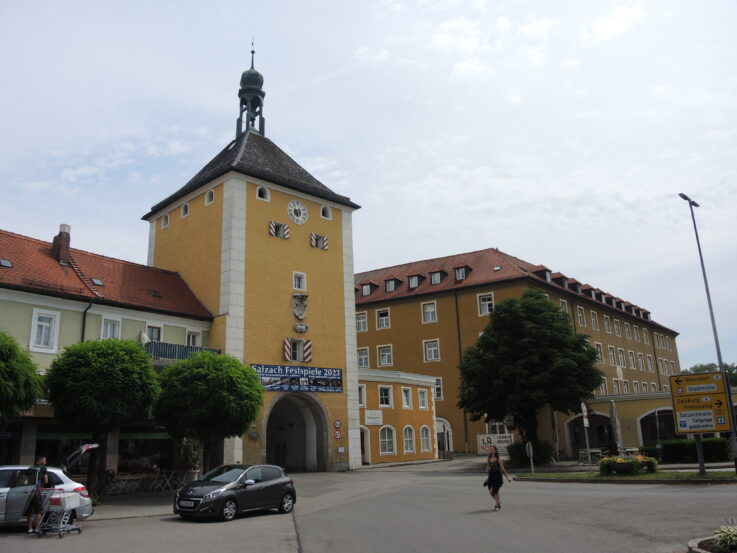
This month, Dr Gilly Carr travelled to the German town of Laufen which once held around 500 Channel Islanders as civilian internees. The aim of the trip was to visit the graves of those who died and to examine the site of the former camp to see what remained. Dr Carr is currently writing a book on the deportations from the Channel Islands to the camps of Dorsten, Compiegne, Biberach, Wurzach and Laufen and has now visited all of these places today. Her book focuses on the objects and artwork made in the camps, using these as a way to understand the experience of deportation and internment. Visiting the sites of the former camps is important in allowing proper understanding and interpretation of camp, its rooms and its grounds.
During the trip to Laufen she was accompanied by local archivist, Thomas Doerring, and Lena Thurnhausstatter, who recently completed a dissertation on the camp. They visited the town’s ‘new cemetery’, near the train station, to see the current graves, as well as the ‘old cemetery’ where those who died in the camp were originally buried. Of the camp itself, to the right of the tower shown in the image, the main building (Schloss Laufen) which held the islanders still stands. Today the interior of the Schloss has been remodelled and is now used by a variety of businesses; however, it was still possible to enter and to match up images of the camp and the inner courtyard with sketches reproduced in the camp publication ‘The Birdcage’. The building behind the Schloss still stands: this is where a similar number of American internees were housed. It was also still possible to see some of the camp grounds, but the exercise area in front of the camp is now a car park. The trip was very successful and ended with discussions of an exhibition in the town in 2025 to mark the 80th anniversary of the liberation of the camp.
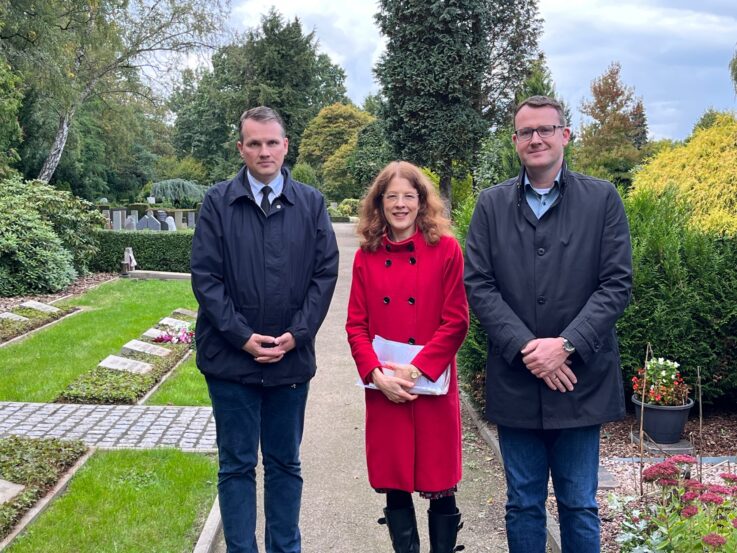
28 September 2022
28 September 2022 marked the 80th anniversary of the arrival of 1,194 Channel Islanders in Dorsten. They had been deported during the first wave of mass deportations that month and were en route to Biberach civilian internment camp. They spent 7 weeks in Dorsten in northern Germany, a period that has been largely overlooked in history and memory because of the brevity of stay and because of the dark and distressing experience of internment in the city. The Islanders from Guernsey and Jersey were placed in a camp on the outskirts of the town and next to a canal. The camp had been vacated days before hand by Polish POWs and was in a very bad condition – wholly unsuitable for women, children and babies. The toilets were holes in the ground; there were no Red Cross parcels and the hunger, cold weather and insanitary living conditions caused the death of three islanders in 7 weeks. 68 year old James Waters died of pneumonia 2 weeks after arrival, followed by 4 month old Brian Skipton, also from pneumonia, and then Florence Manning died of pulmonary oedema on the day of departure, 1 November 1942.
On 28 September 2022, Dr Gilly Carr arrived in the city as a representative of the Guernsey Deportee Association. She was met at the cemetery by Mayor Tobias Stockhoff, his chief of staff Karsten Hartmann, and archivist Martin Koecher. Together they laid flowers on the graves of the Islanders, who lay alongside Polish POWs in the city cemetery. A prayer was said and the Mayor committed to having the graves cleaned and re-lettered to make them legible once more. Afterwards, Dr Carr and Herr Koecher visited the site of the camp. Although the land is today used by the local archery club, traces of hut platforms and camp features are still visible. The three surviving concrete buildings of the camp are today used for social housing. The mayor of Dorsten also committed to raising an information plaque in the town about the camp. The 80th anniversary was thus suitably marked and the mayor expressed a desire for links to be forged between Dorsten and the Channel Islands.
Dr Carr published articles about the visit in the Jersey Evening Post and the Guernsey Press. Dorsten Archives has also posted about the visit on Instagram.
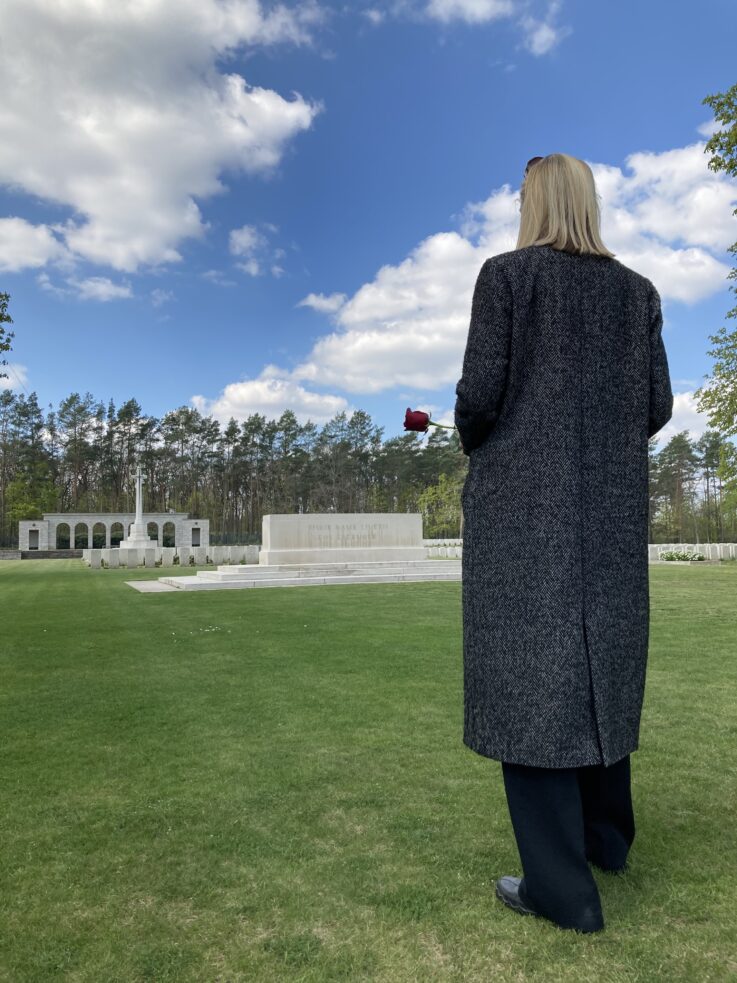
In April this year, Sandra Wakeham, niece of George Fox, travelled to France and Germany with Dr Gilly Carr and Channel TV to follow in the footsteps of her uncle in order to pay tribute to him, to honour his memory, and to raise awareness of his story.
We travelled first to Dijon, to Fort d’Hauteville Prison. Today this site is empty; many of the outer buildings had been knocked down and the rooms inside fort itself are in a state of decay, although the stone structure of the fort is still in a sturdy condition. We found the room in which George was held, and discovered how freezing cold the fort was, despite the warm temperatures outside. We also visited the archives in the town and examined the prison records to find that of George, and of a number of other Channel Islanders.
We then travelled on to Germany, to Naumburg, to visit Naumburg Prison. Today this building is being bulldozed and we were in time to view the old cells and cell doors. Neither Fort d’Hauteville nor Naumburg Prison had any memorial plaque outside to commemorate those who suffered during the war. We also visited the archives in Naumburg to see the death certificates of the four Channel Islanders who died in the prison. We found that George died of sepsis following a cut on his hand. We also know he carried out forced labour, digging up unexploded bombs and clearing bomb damage, so it is sadly clear now how he cut his hand.
Finally we travelled to Berlin to visit the Commonwealth War Graves Cemetery, which are shown in the image featured here. We laid flowers on the graves of George Fox, Frederick Page, Clifford Queree and Emile Paisnel. These four men were exhumed from Naumburg in 1949 and moved to Berlin.
The documentary made by Channel TV was shown in three parts, each of five minutes, which can be viewed here. The first part was filmed in Jersey, the second in France and the third in Germany. Sandra Wakeham also wrote a blog piece for Channel TV about her impressions of the trip.
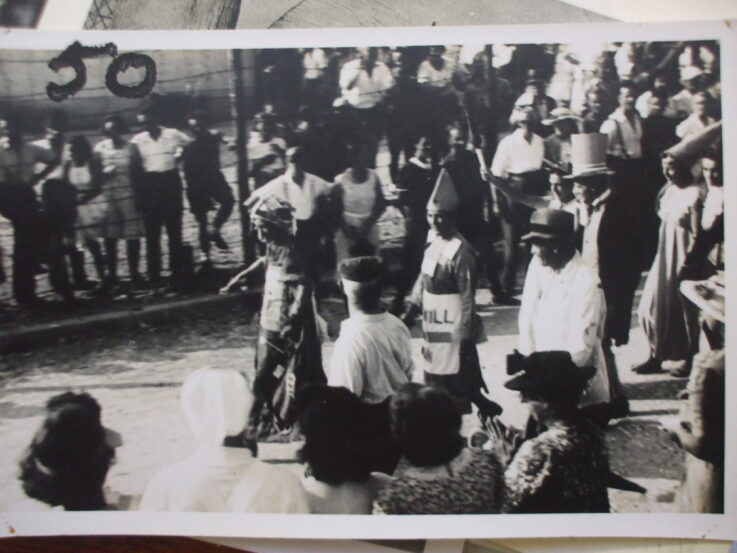
March 2022: Biberach camp film online
Whilst Channel Islanders were interned in Biberach civilian internment camp, Herr Meyer, one the German officers in charge of the camp, made a cine film of internees’ ‘August Bank Holiday carnival’. This was an event held in the camp in 1943 to lift people’s spirits. People made their costumes and props out of bed boards, Red Cross parcel crates, mattress covers, and anything they could get their hands on. We do not know whether the film was made in a spirit of friendship (the internees got on well with Herr Meyer, who was kind to them), or whether it was a German propaganda film made to show ‘how well the Germans were treating the British internees.’ What we do know is that a copy of the original cine film was given (one way or another!) to the internees. Eric Sirett, a former internee from Guernsey, provided the voice-over, although we do not know how much later on this was done. The original film was silent. The film was, in due course, copied from cine film to video (a process which seems to have involved videoing a projection of the original cine film), and from video to DVD, and from DVD to a newer digital format. The version which we can view today is not great quality because of these changes. While the whereabouts of the original cine film is now unknown, a digital copy can be seen here. This version was made using the ‘share screen’ function on a Zoom call, which inevitably further decreases quality; nonetheless, this is the first time that the film has been put online. The film is interesting because, thanks to Sirett’s voice-over, we can get an insight into the creativity of islanders in the camp and the ways in which they tried to make the best of their life behind barbed wire, which lasted beyond the end of the war and until they could be flown to the UK by the Americans in June 1945.
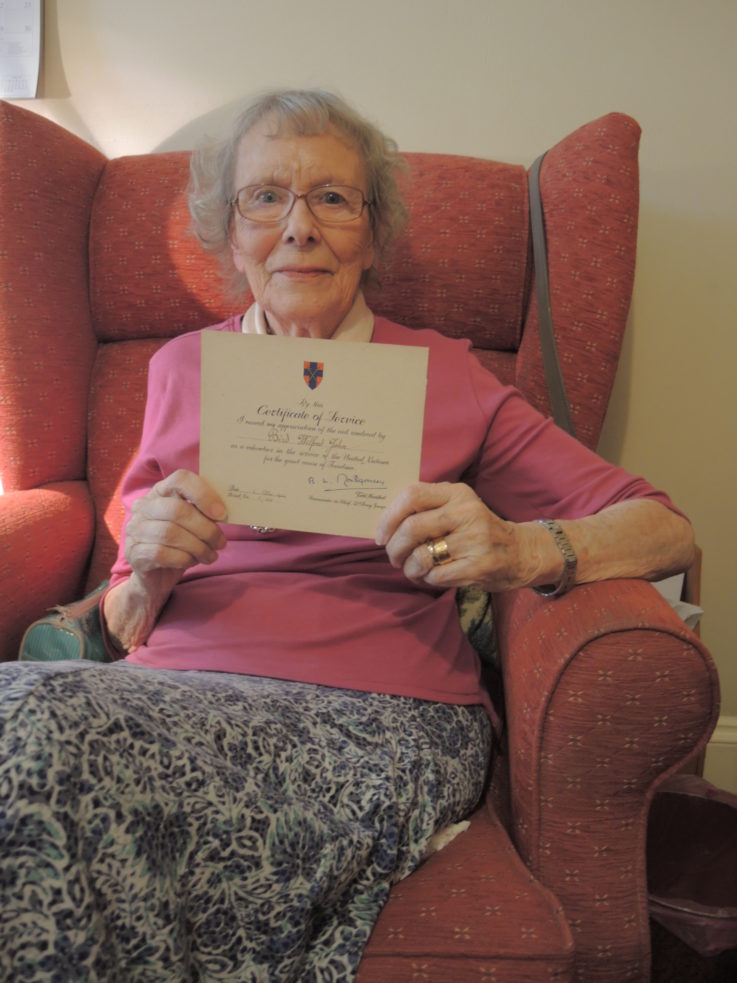
We regret to announce the passing of Guernsey’s last known political prisoner. Mary Bichard nee Bird passed away on 23 January 2022; her funeral was on 1 February 2022 at the United Reformed Church in Guernsey.
Mary Bichard will be best known to readers of the Frank Falla Archive by her maiden name of Mary Bird. She was deported to Cherche-Midi Prison in Paris in 1940 as part of her role in what was known later as the ‘Symes-Nicolle Affair’, which can be read about on this website under Mary’s entry.
Mary was interviewed in 2015 (shown in the image here) and was able to fill in some gaps about her experiences in prison. This was the first time that she had spoken about her ordeal; she was 95 years old by then. In the photo she holds a Certificate of Service given by Field Marshall Montgomery to her father, Wilfred Bird, who was also imprisoned in Cherche Midi at the same time. This certificate appears – unfortunately – to have been given only to imprisoned men.
The Frank Falla Archives sends their condolences to Mary’s family, and most especially to her daughter Jeanne Gathercole, son Allan Bichard, and Mary’s four grandchildren.
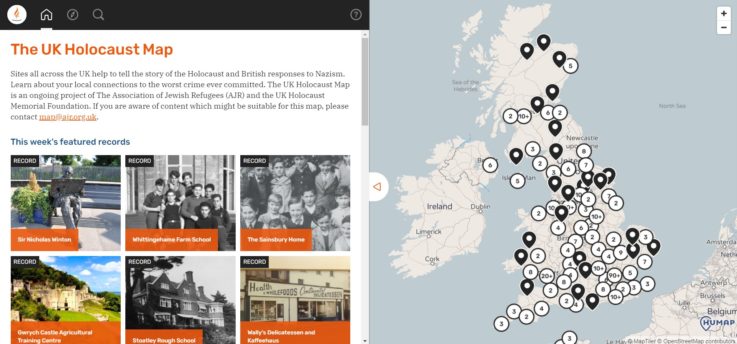
16 December 2022: Launch of UK Holocaust Map
The Association for Jewish Refugees (AJR) has launched a new online digital resource: the UK Holocaust map. This resource will allow users to search and research places across the UK and Channel Islands which are linked in various ways to the Holocaust. The Frank Falla Archive is proud to be a part of this project, and a number of people on this archive, such as Jews deported to concentration camps, are included on the map. Sites in the Channel Islands linked to the Holocaust in other ways, such as the 1940 internment camps for enemy aliens in Jersey and Guernsey (in which some Jews were also interned) are featured, as are two of the camps and the cemetery / mass grave in Alderney. Viewers of the Frank Falla Archive are invited to click on the new map and explore more for themselves!
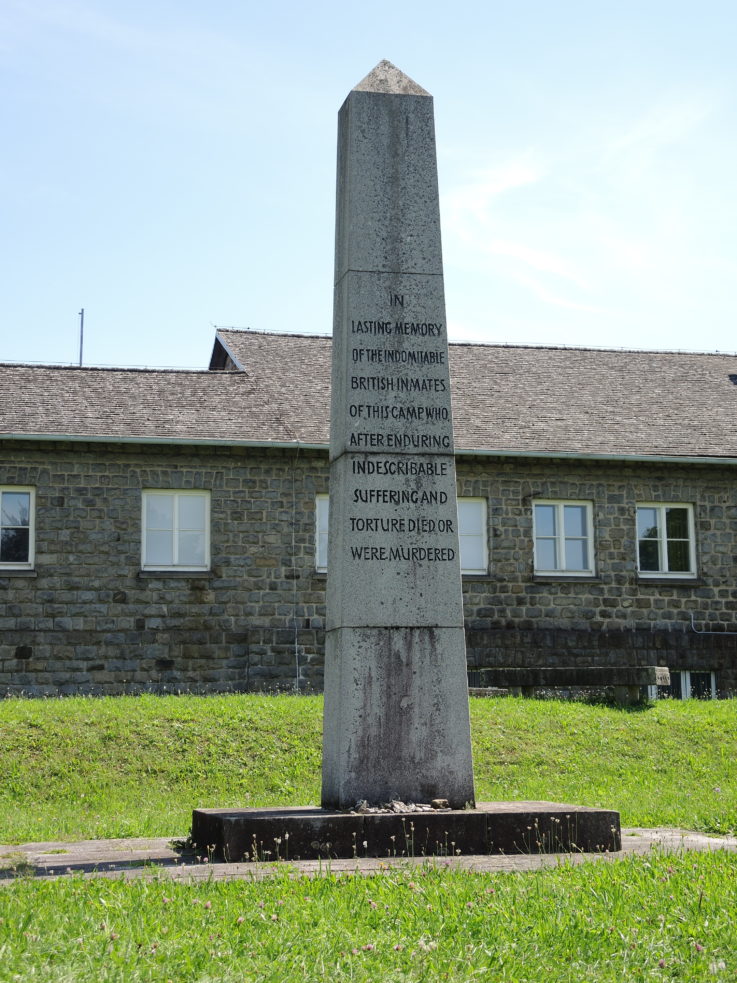
In mid-August, Dr Gilly Carr was fortunate enough to be able to visit Mauthausen concentration camp in Austria with her research team. This concentration camp is of interest to us here at the Frank Falla Archive because it was the final destination of Jersey’s Anthony Faramus, deported in January 1942 aged 21 through seven different camps including Buchenwald concentration camp.
Mauthausen is not primarily a place of victimhood for Britons, although there is a memorial for British citizens of the camp (shown here). Only a small handful of prisoners were British, most of them in the armed forces. Wherever Britons were prisoners, they were always vastly, vastly outnumbered by other nationalities, and among the many tens of thousands of other prisoners, it was difficult for Britons to find other Britons, or even people who could speak English. Unless a prisoner could speak one of the languages which predominated in the camps, their death was certainly hastened because they could not understand commands, which left them vulnerable to beatings. Although Faramus spoke French, his life was in serious danger after so long in the camp system. In Mauthausen he had gangrene in a wound on his thigh, diphtheria and malnutrition-induced blindness. He later wrote about Mauthausen that, ‘unlike at Buchenwald, where murder was unhurried, killing in Mauthausen was an industry maintained at full speed.’ Elsewhere he wrote that ‘conditions were unimaginably shocking. I had thought that there was no hell on earth to equal Buchenwald – but here rotten bodies littered the blocks and streets, giving off a sour stench that was impossible to escape.’ Faramus owed his life to the friends in the camp who helped him, and to his British nationality.
After such suffering in the Nazi camp system for so long, Faramus suffered from bad PTSD after the war. He also had severe TB which necessitated the removal of eight ribs and the permanent collapse of a lung.
Gilly believes that visiting places where Channel Islanders were incarcerated gives us a chance to honour their suffering, remember them, and make a commitment not to forget the human rights abuses that happened to millions of people during WWII.
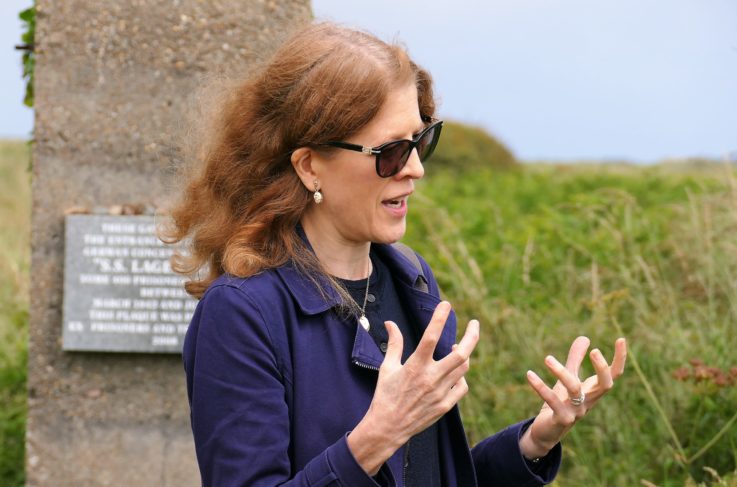
In early July, Dr Gilly Carr travelled to Alderney with Lord Eric Pickles, the UK’s post-Holocaust issues envoy, and Sally Sealey, his chief of staff. They visited in their capacity as members of the UK delegation to IHRA, the International Holocaust Remembrance Alliance, where Gilly chairs the project ‘Safeguarding Sites‘, which is writing guidelines to safeguard Holocaust sites in Europe. Alderney is one of the five sites that the project is working with. During the visit, Gilly Carr unveiled the series of 8 recommendations for the island made by her team of international experts on Holocaust heritage. This was the first opportunity to visit Alderney since the island opened up again during the pandemic.
Gilly made a presentation to the local community which can be watched here on YouTube.
The recommendations for the Island’s sites of Nazi persecution are as follows:
A report on the visit to Alderney can be seen on the IHRA website.
The eight recommendations were shown to the States of Alderney, a selection of local stakeholders and the local community. We now enter a period of discussion to find ways to make these recommendations of best practice work for Alderney, which pledged to work with IHRA in 2019.
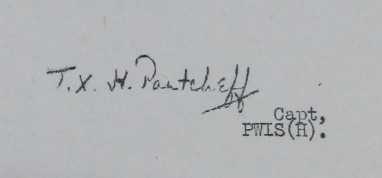
In recent days, there have been a number of articles published in the media in both Alderney and England regarding the Pantcheff Report. This report was compiled in 1945 by Captain Theodore Pantcheff following his investigations into atrocities in Alderney. This report is on open access at The National Archives in Kew, in archive reference WO 311/13. It has been on open access, free to be consulted by anyone, since at least 2009 and probably earlier. The author’s copy was taken in 2016.
The atrocities on Alderney have been discussed by a great many historians to date, including Madeleine Bunting (The Model Occupation, published 1995), Freddie Cohen (The Jews in the Channel Islands during the German Occupation, published 2000), Paul Sanders (The British Channel Islands under German Occupation 1940-1945, published in 2005), Hazel Knowles Smith (The Changing Face of the Channel Islands Occupation, published 2007), and more recently, research by Caroline Sturdy Colls, (Holocaust Archaeologies), her publication on Lager Sylt in the journal Antiquity, and in her forthcoming book (Adolf Island), due out later 2021. Before any of these authors, Solomon Steckoll also discussed atrocities in Alderney in 1982 in his book ‘The Alderney Death Camp’. Theodore Pantcheff even published his own book in 1981 based on his investigations.
In summary, the events in Alderney are well known and the contents of Pantcheff’s report (which include witness statements by George Pope) have been discussed by many. Recent claims to have found this report in Moscow and to have revealed them ‘for the first time’ are false because the Moscow copy has been discussed by many of these authors before. Should there be any doubt that a copy is not available at the National Archives, Professor Caroline Sturdy Colls has put her copy, accessed in 2009, online here with the permission of the National Archives.
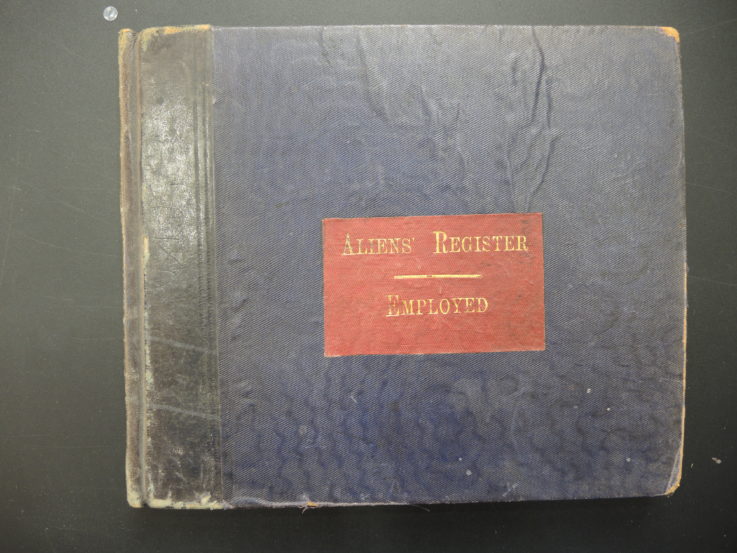
8 May 2021: New insight into identification of Guernsey’s Jews
Drawing on an article recently published by Gilly Carr in the Journal of Holocaust Studies, some of the more important findings were reproduced in the Jersey Evening Post for a double page spread on 8 May 2021 as a Liberation Day special. The original academic journal article can be seen here.
There are four key findings in the original article. They are, first, that the logbook of employed aliens (kept as a closed file at the Island Archives, Guernsey) shows the arrival of over 900 people from a variety of European countries to Guernsey during the 1930s, a number of them, Jews. There was a particular increase in Austrians, Germans and Hungarians as those from these countries fled the rise in antisemitism as the Nazis and – in Hungary – antisemitic Arrow Cross party came to power. All Austrians and Germans without British citizenship (all of whom were female) still in the Island in 1940 were interned from May to June of that year before the Germans arrived.
The second argument in the article is that the interned women because very close to each other, as confirmed by the children of these women still living in Guernsey today, and – we can suggest – shared with each other their reasons for leaving their homeland. It seems very likely that the Jewish women confided in each other – and possibly the others – their Jewish identity. In October 1940, when the Germans passed their antisemitic legislation in the Royal Court, they also interviewed each of the formerly interned women. Given the coincidence of timing, we can assume that the Germans asked the women about their Jewish identity and that of those they were interned with, giving threats of imprisonment and deportation. Did Therese Steiner and Auguste Spitz confess their identity because they didn’t know if they could trust their new friends to stay silent?
The third argument in the paper is that, by following the stories of the Channel islands’ Jews, we can see which Jews were more protected / at risk of persecution and deportation than others. The most vulnerable were single Jewish women without British nationality, followed by single Jewish men, and then Jewish women married to non-Jews, Jewish men married to non-Jews. Jews who were prepared to lie about their identity and who had no J-stamps on their papers were the next at risk. Jews born British could hide in plain sight. As the local authorities had no lists of them to hand over to the Germans (at least in Guernsey), they were not rooted out.
The fourth and final major finding concerns the logbooks themselves. They provided a very ready source of information about the newly arrived foreigners in the island – their names, nationality, dates of birth and places of birth. When the Germans asked for lists of different categories of people, the archives show that these were always handed over promptly and without complaint by the local authorities in Guernsey. Ambrose Sherwill, Victor Carey, and William Sculphur were all implicated in this as their names can be found at the bottom of the letters concerned. They could have told the Germans that they had no lists of foreigners. They could have destroyed the aliens logbooks. They could have said that the Lieutenant Governors took them to England. They could have hidden them. They did none of these things. In this way, the local authorities in Guernsey were complicit in handing over Jews to the Germans.
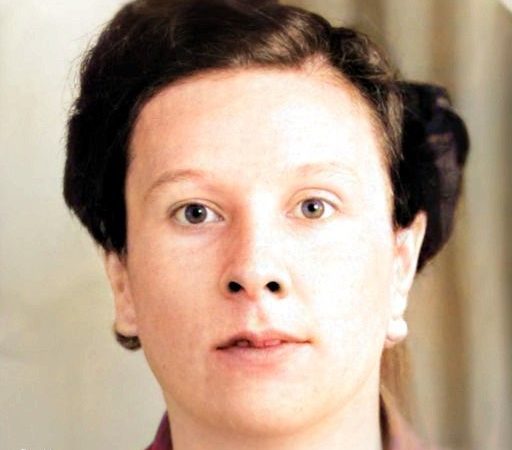
This week, social media has been full of animated photos of the dead using ‘deep fake’ (or ‘deep nostalgia’, as they call it) technology. An ancestry website company, MyHeritage, has offered (for a fee), as part of their subscription, a service which ‘enhances’, colourizes and animates old black and white photos. The aim has been for people to animate images of long dead ancestors on their family tree, but many people have been experimenting – as have I – with images of those who died during the war. Specifically, I have been experimenting with images of those who lived during the occupation and who died in (or survived) Nazi prisons and concentration camps. I have been looking at images of those on this very website.
I have put just a few on social media, such as Dorothea Le Brocq (shown here) and Albert Bedane, both of whom have been given the honour of ‘Righteous Among the Nations’ by Yad Vashem for saving the life of Jews by hiding them in their homes in St Helier, Jersey, during the occupation. But there is something deeply uncanny and uncomfortable about the animated versions of old photos. Is it ethical to post them online? This is the first question. These people have not given their consent (indeed, they cannot), and neither have their families. Is it exploitative? And is it authentic? These are not even accurate videos of people, as experiments with animating images of myself have quickly shown.
On the one hand, it is fascinating, amazing, even magic to ‘bring the dead to life’ in this way, but of course we are doing no such thing. Yet it is the closest thing we have to seeing ancestors and loved ones again. There is a feeling of ‘coming to know’ the dead better by seeing them in colour and animated. Dorothea Le Brocq is an entirely different woman when animated, compared to her black and white photo. One cannot help but feel that this is surely what she was like. But on the other hand, it is also deeply distressing for relatives to see their loved one ‘again’ in this guise. When I first got a subscription to the website 48 hours ago, in my excitement I placed an animation online on the closed Facebook group ‘Channel Islander victims of Nazism’, notifying the relatives that I had done so with an offer to remove it. Within an hour, they had asked me to take it down, which I gladly did. Yet on the same site, others were asking me to animate their loved ones, and finding the result deeply interesting.
For those who would animate these images, perhaps of Holocaust victims, we need to understand that there are ethical issues with this. We do the dead a disservice if we use their images for our own ends, without their permission or that of their family. We might also add to the trauma of the family if this reanimation of the dead is done without permission or warning. Does it matter whether these people are our relatives? Or soldiers instead of Holocaust victims, or that they died much longer ago? Do anything of these things change the ethical perspectives? Perhaps such animations – if we do them – need to remain in the private sphere.
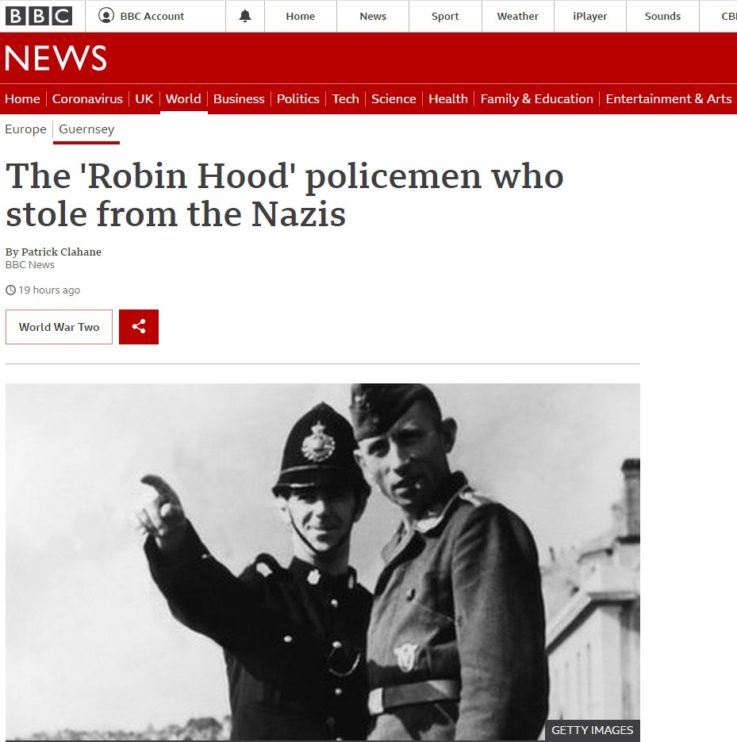
Today the BBC published a news item written by Patrick Clahane, which brings the news that Privy Council refused an appeal in March 2020 this year – just before the pandemic began. This was an appeal against the conviction of the Guernsey policemen in 1942 in a show trial, headed by then-Bailiff Victor Carey. The men were also convicted by a Nazi court in Guernsey. It is extremely unfortunate that, in going through with the show trial, Carey was reinforcing the Nazi court’s conviction and acting as what many outside the island would recognise as a collaborator, although this is a very sensitive issue and such terms are not used locally.
The policemen were sent to Nazi prisons, labour camps and concentration camps, where one of their number was murdered by a guard and most of the others returned with PTSD and chronic ill-health and injuries which stayed with them for the rest of their lives.
In 1955 they tried to appeal to the Privy Council against the wartime conviction but were unsuccessful. Earlier this year the appeal was once again turned down on the grounds that ‘complaints of mistreatment inducing confessions could have been raised’ in 1955 but were not. In other words, because the extraction of confessions through torture was not brought up in 1955, it could not be used now, even though it is well documented that it happened. As Patrick O’Connor QC who took up the case pro bono (without payment) said, ‘There is no other procedure to overturn these convictions. Unfortunately, this leaves this show-trial as a stain against the Guernsey system of justice which will remain for good.’
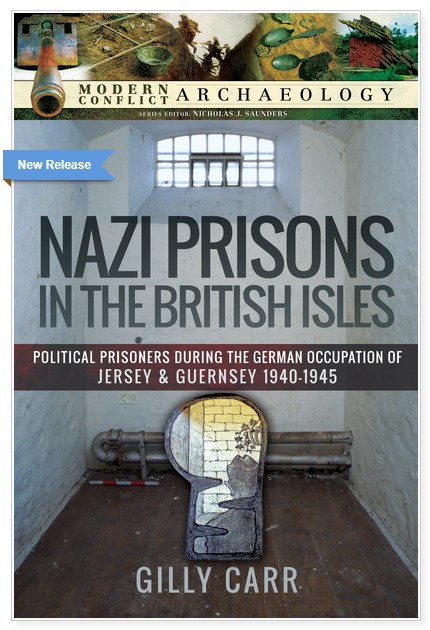
Nazi prisons in the British Isles by Gilly Carr (published by Pen and Sword Archaeology) has just been released. This book brings together all available evidence for Guernsey and Jersey prisons during the German occupation. Drawing on archival documents from Jersey Archives, the Island Archives in Guernsey, the Imperial War Museum and National Archives, interviews with former political prisoners, unpublished and published memoirs and diaries, this book reveals the truth behind how political prisoners were treated. It also highlights the differences between Guernsey and Jersey prisons, and between these island prisons and Nazi prisons on the continent. Were the prisons a hotbed of solidarity and defiance, or were they places of brutality and forced labour? How did the prisoners of the Germans communicate with each other while kept in solitary confinement, and what measures did the prisoners take to make sure that they would not vanish without trace? Building on earlier research on resistance in the Channel Islands, and the treatment of islanders in Nazi labour and concentration camps in Europe, this book puts Guernsey and Jersey prisons in context. This book is aimed at a non-academic audience and is illustrated with many new images. It is available from Pen and Sword books here.
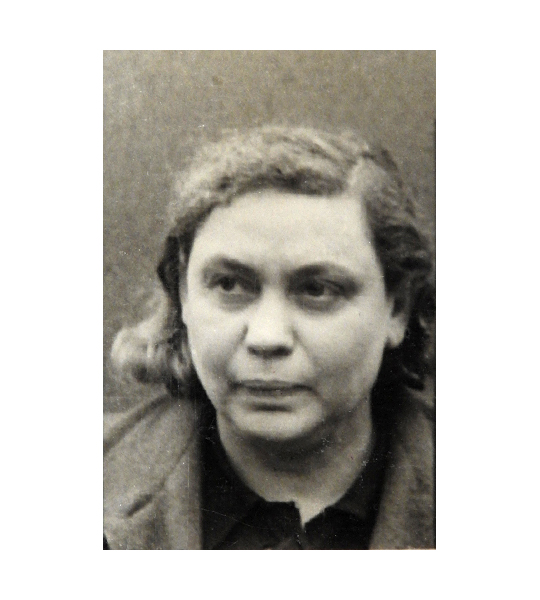
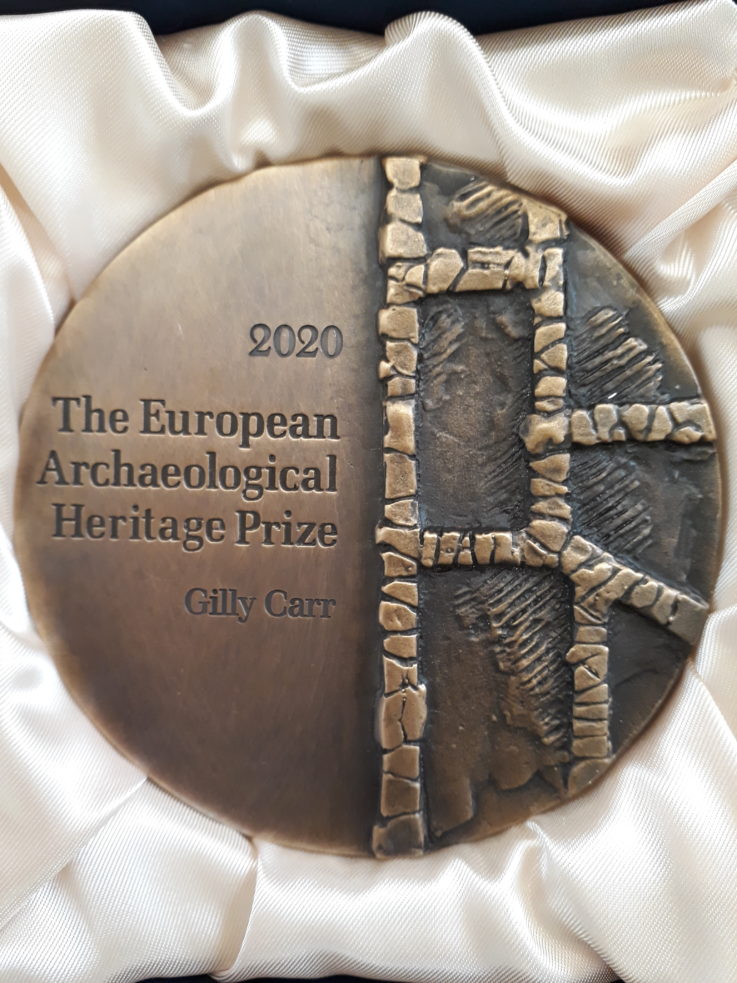
On 25 August, Dr Gilly Carr, director of the Frank Falla Archive website, was awarded the prestigious European Heritage Prize by the European Association of Archaeologists, for her work in promoting the cause of Channel Islander victims of Nazism. This work has included museum exhibitions, memorial erection, excavations, ceremonies, TV documentaries, and finding the dead lost in the Nazi camps system.
In her virtual acceptance speech, Gilly said ‘it is the political prisoners who have a special place in my heart. They were those who were imprisoned or deported to Nazi prisons, labour camps and concentration camps for acts of protest, defiance and resistance. During and after the occupation, they were seen by most of those in positions of authority as trouble-makers who deserved everything they got. Their experiences in prisons and camps were seen as a punishment of their own making. They did not receive any honours after the war … I therefore wish to dedicate this award to the political prisoners of the Channel Islands. It seems appropriate to do so in this year of the 75th anniversary of the liberation of the camps, and at a time when nationalism and far-right politics is once again increasing in Europe. I dedicate the award to those who fought against such ideologies.’
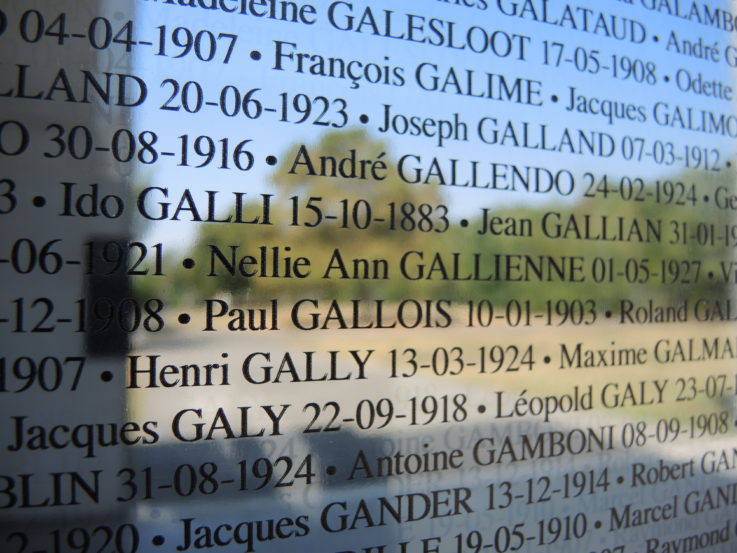
In 2008, a deputation of people from Guernsey, accompanied by Geoffrey Rowland, then Bailiff of Guernsey, visited Compiegne transit and internment camp for the opening of the memorial and museum at the site. Neither the director, nor any of the distinguished guests knew that Channel Islanders had been held in the camp for three months from February 1943. In fact, the Wall of Names at the entrance to the camp did not include the names of any islanders. Tom Remfrey, chair of the Guernsey Deportees Association, handed over a folder of information to the director; it included a list of interned islanders.
A second trip made to the camp in August 2020 showed that the list of names had now been included in the Wall of Names. The image shown here shows Nellie Ann Gallienne, better known now as Nellie Le Feuvre, who lives in Sark.
Despite this very positive and important addition, the Channel Islands are still not shown on a map of Europe within the exhibition, and nor do they feature in a diagram showing from which locations people were sent to the camp.
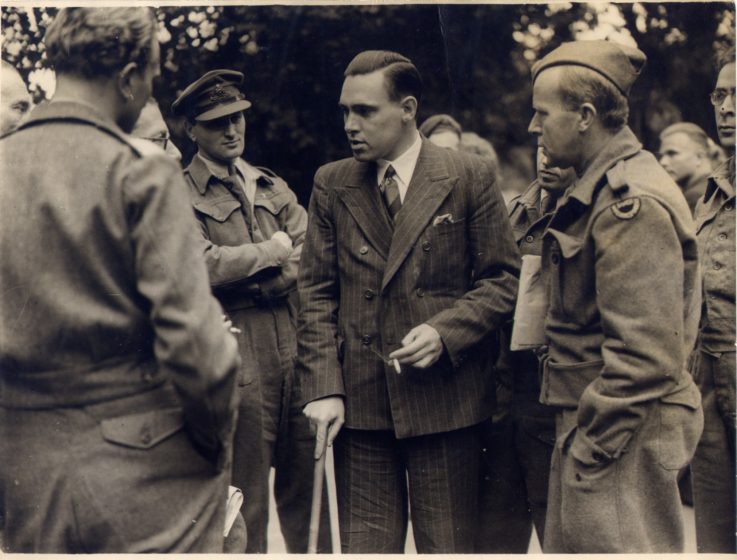
15 April 2020: 75th anniversary of the liberation of Bergen-Belsen
Although well known in the Channel Islands, the name of Harold Le Druillenec of Jersey is lesser known elsewhere. Believed to be the only British citizen still alive at the liberation of the camp, Harold was a remarkable man. A video has been made to commemorate the 75th anniversary of his liberation.
A school master in Jersey at the outbreak of the German occupation, Harold was complicit in helping his sister, Louisa Gould, and others, shelter an escaped Russian slave worker. He also illicitly listened to the radio with them. After being informed upon by neighbours, Harold, Louisa and their friend, Berthe Pitolet, were deported at the end of June 1944. They were sent to a variety of prisons in France, from where Berthe escaped after a bombing raid. Louisa and Harold were sent to camps in Germany. By the end of the war and the liberation of the camps, only Harold was still alive. He was rescued by British forces and was put in hospital for five months. In 1945, ’46 and ’47 he testified at war crimes trials. He also described his experience for the BBC in 1945 and 1946. His story deserves to be more widely known.
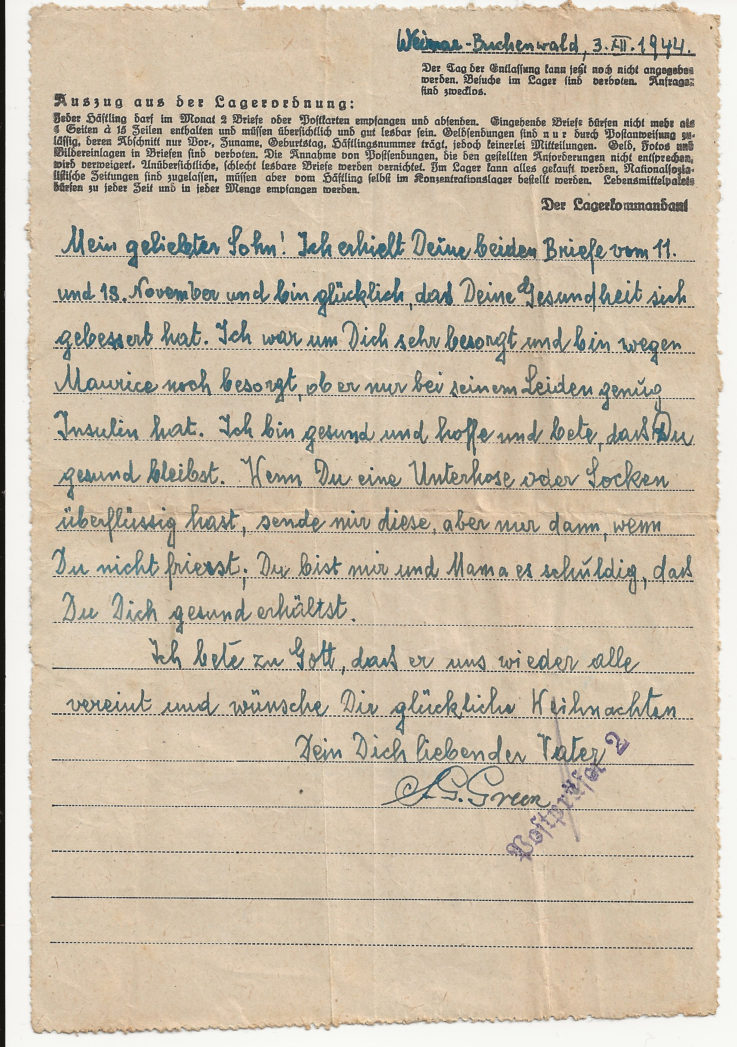
The archive of Stanley Green, a Jersey survivor of Buchwald concentration camp, has come to light, found in the possession his grand-daughter in Peterborough. Stanley’s son, Leslie, was sent to Laufen civilian internment camp. On receiving two letters smuggled out of Buchenwald by his father, he was able to ask others in Laufen to help him contact the Red Cross to get Stanley transferred to Laufen. This saved his life.
The archive contains letters exchanged between Stanley (in his Nazi prisons and in Buchenwald) and Leslie in Laufen, coupled with letters from other members of the family in Jersey. It contains Leslie’s artwork drawn in Laufen, as well as various documents from that camp. The story of the Green family during the Occupation is captured in the letters, and covers the struggle to get insulin for Maurice, Leslie’s brother. Finally, the archive clarifies some of the false stories surrounding Stanley Green’s experiences in Buchenwald. Some of these stories originate with Maurice and have now been shown to be incorrect, including the claim that the Green family had Jewish roots and that Stanley took photographs in Buchenwald, which he smuggled out.
The archive will be studied in depth and then passed to Jersey Archives.
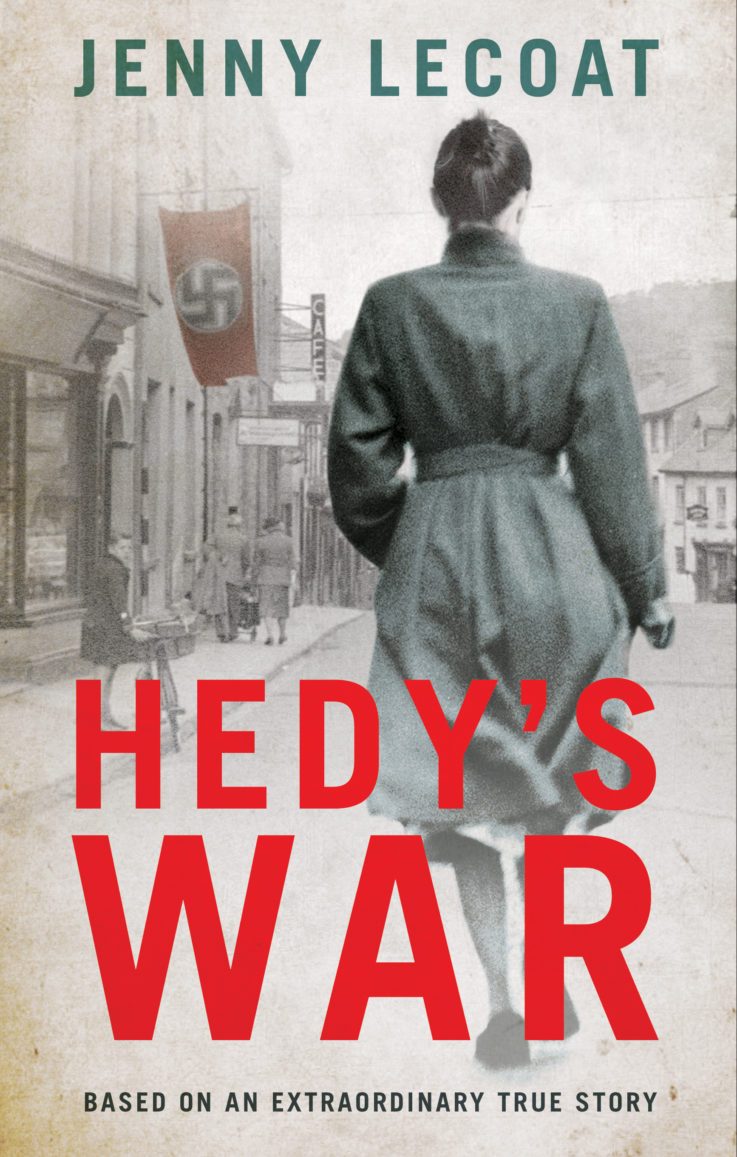
News has reached the Frank Falla Archive today from Jenny Lecoat, screen writer of Another Mother’s Son. A couple of years ago, Gilly Carr gave Jenny Lecoat her research notes for her academic journal paper on Jersey’s Dorothea Le Brocq and the Jewish woman she hid,during the occupation Hedwig Bercu. Knowing Jenny was a writer from a Jersey family, Gilly asked her to consider writing the story of Hedy and Dorothea. Jenny was persuaded and the manuscript of the book was completed in 2019.
Today, news has reached us that Jenny Lecoat’s book, titled ‘Hedy’s War’, has been bought by Polygon, with the North American rights brought by publishing giant HarperCollins! Advance orders can be placed through Waterstones here.
Congratulations to Jenny! And save a seat for us at the Oscars when the film rights have been snapped up!
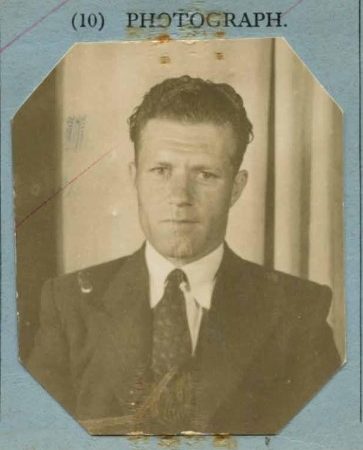
Recent discussions with Stuart Nicolle at Jersey Archives has identified a hitherto under-researched period of deportations during the Occupation. 2 January 1942 marked the date when the American men of Jersey were deported. Preliminary research indicates that only single men were deported at this time, but this was not exclusively the case. The American women were not deported but had to report to the responsible constable weekly. This information was then submitted to the Germans. Thus far, it seems that four men were deported: Charles Daly, shown here; Joseph Boulvard; Andrew Carrick; and Thomas Curwood. The men were sent to Compiegne transit camp, just outside Paris, where there was a compound for interned Americans, rounded up after America entered the war following the attack on Pearl Harbour. The men were well-treated in this compound and were still there when further Channel Islanders joined them after being deported in February 1943. These people were later moved on to Biberach civilian internment camp, where they arrived on 21 May 1943.
We do not know where the American men went. Did they stay the war in Compiegne? Were they sent to other civilian internment camps such as St Denis, in Paris? Charles Daly – and he alone – was sent back to Jersey, arriving 11 May 1943. Why was he allowed to return to the Island? Was it because of his job in food production as a farm worker, or was it because he was the only one of the four men with a wife and small child? The Frank Falla Archive would like to invite his son, Frederick Charles Daly, to get in touch.
What of the Americans deported from Guernsey? Although no research has yet been carried out into this, we know that Arthur and Millicent McGahy were deported at the same time as the Island’s Jews in April 1942, accompanying them to France. We know that Arthur joined the other men in Compiegne, but Millicent’s wartime location is unknown. This episode is still a largely untold story of the Occupation.
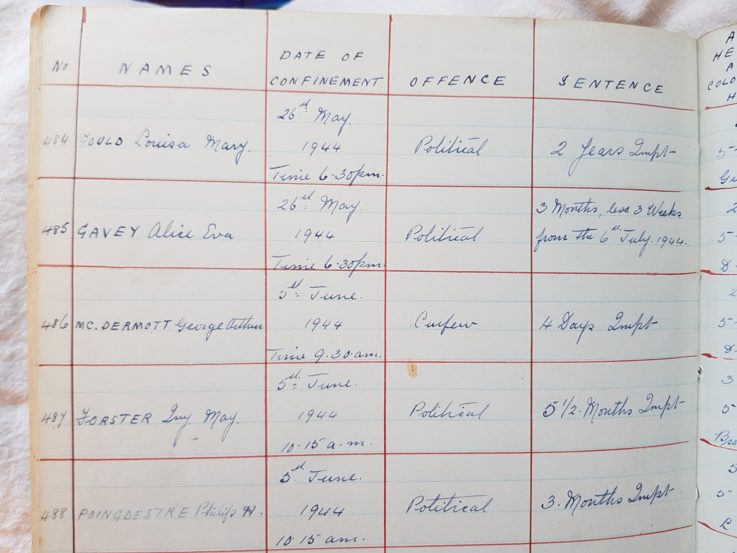
Now that 2020 has rolled around, Jersey Heritage has finally opened to the public the political prisoner logbook. Although researchers (including those who work on this website) have been able to study this book for many years, it is now open to the wider public, although is not yet online. The entries of all of those in the logbook who were deported have their entry visible on this website.
But what is the political prisoner logbook? All those who committed an offence in Jersey during the Occupation were divided into two kinds of ‘criminals’: the ‘civil’ prisoners were those who committed what we might consider ‘ordinary’ crimes, such as burglary and theft – things that would have been against Jersey law in peacetime. Those who offended against German orders (including those who stole from Germans) were labelled ‘political prisoners’, even if their offence was not political as such. These kinds of offences including listening to radios illicitly after they were confiscated in June 1942, hiding a slave worker, or being caught selling on the black market. Anyone charged in the German courts (i.e. court martialled) was written down in the political prisoner logbook. However, it is very important to state that this was a logbook kept by Jersey officials and is not a German archival source. Sometimes people were put in prison and deported and never tried; at other times they were tried and the charge sheet was not passed to Jersey officials. Other times, someone was just kept in prison without a trial. There is also the likelihood that some charge sheets have simply not survived. In other words, the political prisoner logbook is not a complete record, but an almost complete one. Although it goes up to the end of 1944, separate charge sheets cover the period up until the end of the Occupation, and these are available online.
The German record of those tried or put in prison does not survive and so this is the best we have. The important thing about this book is that it notes who was deported, although this is not a complete list either. A similar book survives in Guernsey but this does not list those who were deported, making tracing these people a much harder job. Jersey Heritage is to be congratulated for opening this book at last!
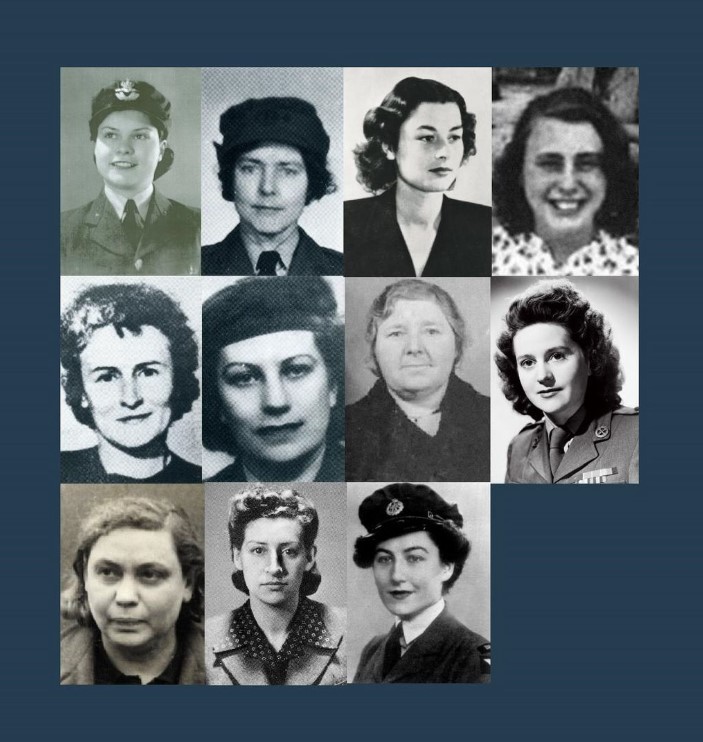
At the end of November 2019, Gilly Carr presented the work of the Frank Falla Archive at the British Embassy in Berlin. The director of Ravensbrueck concentration camp memorial, Dr Insa Eschebach, invited Gilly to speak at an annual fund-raising review of the work of the memorial. The focus for the evening was British women in Ravensbrueck concentration camp; Gilly spoke about the three women deported there from the Channel Islands: Louisa Gould, June Sinclair and Julia Barry, each of whom feature in the Frank Falla Archive.
Louisa and June did not survive the camp, but Julia Barry did and left a wealth of interviews and insights into various aspects of camp life. As she was made a camp policewoman, she had access to all areas of the camp, unlike other prisoners. She was therefore able to testify to crimes not witnessed by others. Julia left detailed testimonies for the war crimes trials, all of which can be found on the Frank Falla Archive.
It is still hoped that a plaque can be placed to Louisa Gould and June Sinclair at Ravensbrueck in the next year or two. Negotiations remain ongoing, and the team at the memorial are keen for this to happen. Progress on this front will be announced on this blog.
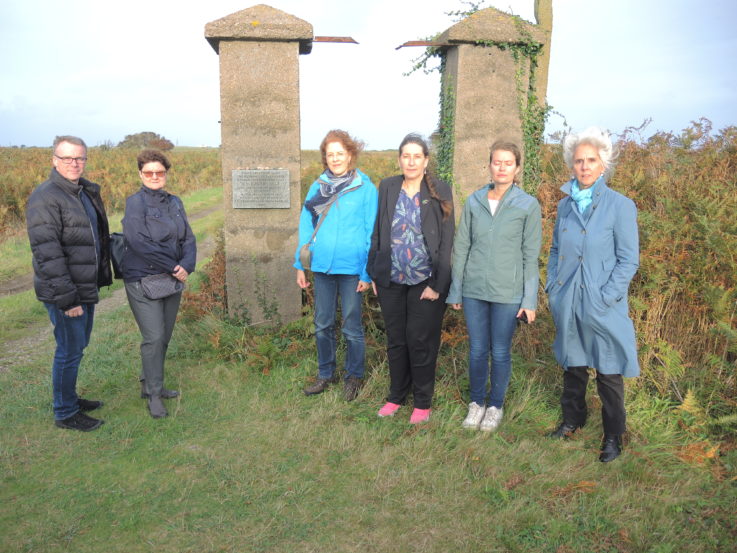
In September, an expert international team from the International Holocaust Remembrance Alliance (IHRA) visited Alderney as part of their five-year project ‘Safeguarding Sites: the IHRA Charter’. The aim of this project is to visit sites connected to the Holocaust and Nazi persecution all over Europe in order to create heritage guidelines to safeguard such sites.
All of Europe, all such sites (whether prisons, camps, mass graves or ghettos, etc) face problems such as decay, destruction, inappropriate reuse, the rise in far-right politics, climate change, natural disasters, graffiti and vandalism, a lack of funding, lack of marking, etc. The heritage guidelines will allow those who look after sites in their area to take care of them in the best way. By drawing on the expertise of an experienced international team, stakeholders will have someone to turn to for guidance when it is needed. The visit to Alderney included stops at Lager Sylt, Lager Norderney, Lager Borkum and Lager Helgoland, as well as Alderney Museum and Alderney Prison. The visit concluded with a meeting with States Members. Further visits are planned.
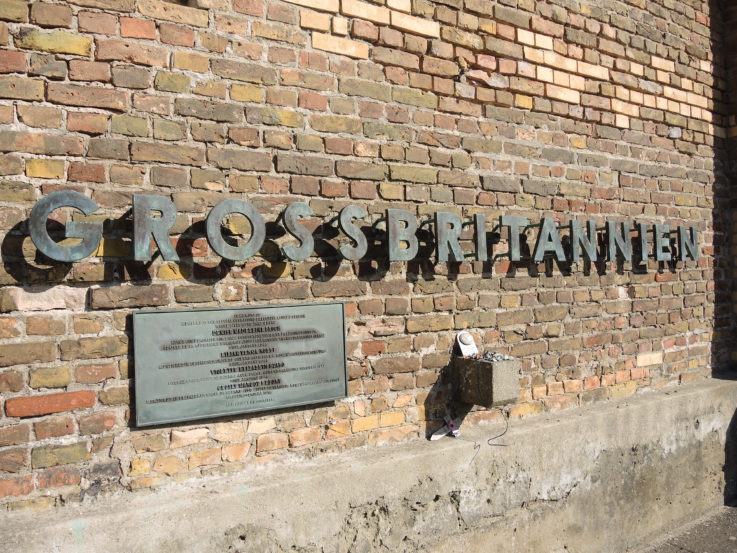
Gilly Carr, director of the Frank Falla Archive, visited Ravensbrueck concentration camp in early September in order to give a lecture. While there, she visited the book of names of those who died in the camp. June Sinclair and Louisa Gould from Jersey were listed. In the exhibition, Julia Brichta was mentioned; she had been deported from Guernsey for black market offences. Julia was a Hungarian Jew, but had never told anyone about her Jewish heritage. She worked as a ‘Lager Policewoman’ or camp police woman in Ravensbrueck; she got the job as she was able to speak many languages. Despite being a prisoner herself, there were a number of prisoners who worked for the SS, and Julia was one of them, but she always maintained that she worked to protect the British women in the camp.
Although there were few British women in Ravensbrueck, aside from the Channel Islanders the others were members of the SOE who had volunteered to go to France to work for the Resistance. Once caught by the Gestapo, these women were sent to concentration camps. A number of them were executed at Ravensbrueck and Julia Brichta was one of the last people to see some of these women alive.
In the memorial area of the camp today there are no memorials to those from the Channel Islands. It is hoped that this can be rectified and the director of the camp memorial today said that she would be delighted to see a memorial to Channel Islanders. The Constable of St Helier has been contacted about this in order to begin the process.
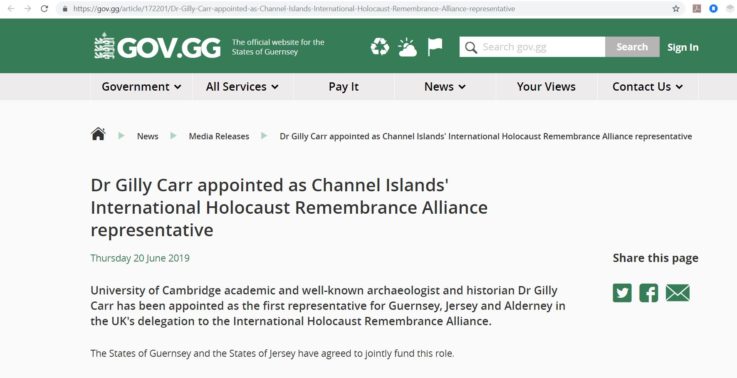
Guernsey, Alderney and Jersey have today announced in a media release that Dr Gilly Carr will be their representative at the International Holocaust Remembrance Alliance (IHRA). IHRA is an organisation that unites governments and experts to strengthen, advance and promote Holocaust education, research and remembrance and to uphold the commitments to the 2000 Stockholm Declaration.
Dr Carr was invited by the Foreign Office to join IHRA as part of the UK delegation in 2016; this announcement formalises Dr Carr’s ongoing activism in heritage and education in the Channel Islands in the field of the Holocaust and wider Nazi persecution. Dr Carr’s exhibition ‘On British Soil’ was shown at Guernsey Museum earlier this year; before that it was on in London at the Wiener Library for the Study of the Holocaust and Genocide. Dr Carr was also responsible for getting Jerseywoman Dorothea Weber nee Le Brocq recognised as ‘Righteous Among the Nations’ by the State of Israel in 2016, an honour followed by the Foreign and Commonwealth Office, who made her as a British Hero of the Holocaust in 2018. Dr Carr has also carried out research which led to the discovery of the last resting places of Sidney Ashcroft, Joseph Gillingham and Charles Machon of the Guernsey 8 and Joseph Tierney of the Jersey 21.
Having carried out research into the German Occupation of the Channel Islands since 2007, focusing on victims of Nazism since 2010, Gilly Carr is very pleased to be able to take on this role to raise awareness of the relationship between the Channel Islands and the Holocaust among both local, national and international audiences. It is anticipated that this role will be advisory and will help the Bailiwicks in the field of education, commemoration, heritage, archaeology and politics. Through her role in IHRA, she will be able to bring international guidelines of best practice in these fields to the Channel Islands, as well as bring issues in the Channel Islands to an international audience.
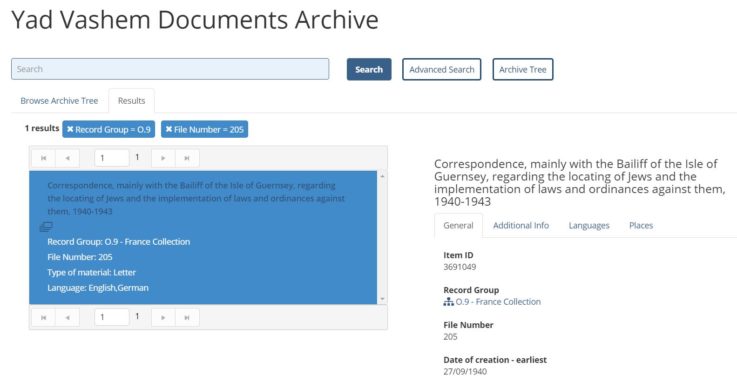
Following a conversation a couple of days ago at the International Holocaust Remembrance Alliance (IHRA) in Mondorf-les-Bains, Luxembourg, Dr Haim Gertner, the Director of the Archives Division of Yad Vashem, the world Holocaust remembrance centre, based in Jerusalem, has emailed Dr Gilly Carr (University of Cambridge) with the news that the Archive’s files related to the Jews of Guernsey and Alderney have now been placed online. They can be viewed here.
Files relating to the Island’s Jews are still closed in Guernsey. The two sets of records have not yet been studied side by side, but it seems likely that there is a degree of overlap.
Now that the files are online, the time would appear to be ripe for reassessing whether Guernsey’s files should be opened to the public. Last year Gilly Carr wrote a blog post on the IHRA website about Guernsey’s closed Jewish files.

Gilly Carr’s latest book, Victims of Nazism in the Channel Islands: A Legitimate Heritage? has been published by Bloomsbury Academic. A special discount has been negotiated for the Channel Islands, where Blue Ormer Publishing is acting as the distributor. The book can be ordered online here. For those not in the Channel Islands, the book can be ordered from Bloomsbury Academic.
Victims of Nazism focuses on the long-term effects of Nazi persecution on the Channel Islands’ political prisoners during the German Occupation and is the first book to do so. It also examines the long-term neglect of their heritage and memory by both national and local governments since 1945.
The three-part book starts with the wartime experience of islanders in Nazi prisons and camps based on their own testimonies, examines the reception they faced on their return, and explores the problems of PTSD shared by many. The second part examines the compensation claims period of the 1960s, the role of Frank Falla, and the way political prisoners were actively excluded from the narrative of the occupation by the local authorities. The third part takes us from the 1960s to the present, looking at the fight for recognition by local ‘guardians of memory’ and the activism of ‘game changers’. The book finishes by examining the status quo today.
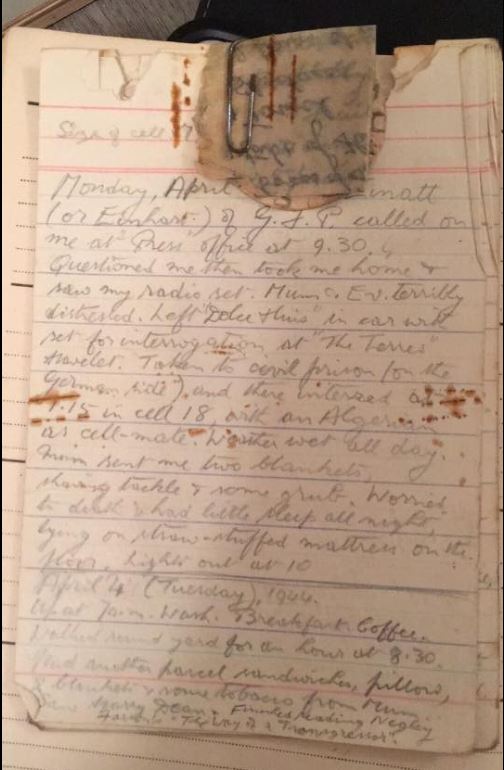
Having recently learned that Frank Falla kept a diary during the Occupation, Dr Gilly Carr (director of the Frank Falla Archive project) was thrilled to find that Falla was also able to keep a diary whilst held in Guernsey Prison for his role in GUNS. Our most pressing questions are surely those which ask what form the diary takes, what it tells us, and how it survives today.
The two-month prison diary, covering the period from 3 April to 3 June 1944, comprises 11 loose and closely-written sheets, torn from a note-book and paper-clipped inside Falla’s 1945 Guernsey Star office diary. As this office diary is regularly kept only from 2 August 1945 onwards, Falla clearly placed the 1944 sheets within this diary on his return to Guernsey after his liberation from Naumburg prison. Because of the good condition of the paper, it seems highly likely that these sheets did not travel with him to Germany, but that he was able to smuggle them into the safe hands of his mother, who he notes in his 1967 memoir, The Silent War, was often able to visit him as he carried out forced labour outside the prison while still in Guernsey. It is also possible that he gave the sheets to a fellow prisoner to give to his mother before his departure on 4 June 1944.
Although a few unpublished memoirs exist of those who were in Guernsey prison, this diary is unique in being the only known surviving daily account of life in this prison. From it we learn more details than were apparent in The Silent War. We discover the names of other prisoners incarcerated in the German side of the prison (all official prisoner logs of which have been destroyed). We learn of the precise date of deportation of eight of these, details of which have now been added to this website. Interestingly, it is clear that prisoners were told of their destinations before deportation – something not known before – as Falla was able to record this. Tucked under the paperclip is a torn fragment of tomato-packing paper on which Falla made a list of personal belongings which were stolen from him in Frankfurt prison.
Gilly Carr is currently writing a book on the regimes inside Guernsey and Jersey prisons during the Occupation; this discovery will add much-needed detail to what we know already.
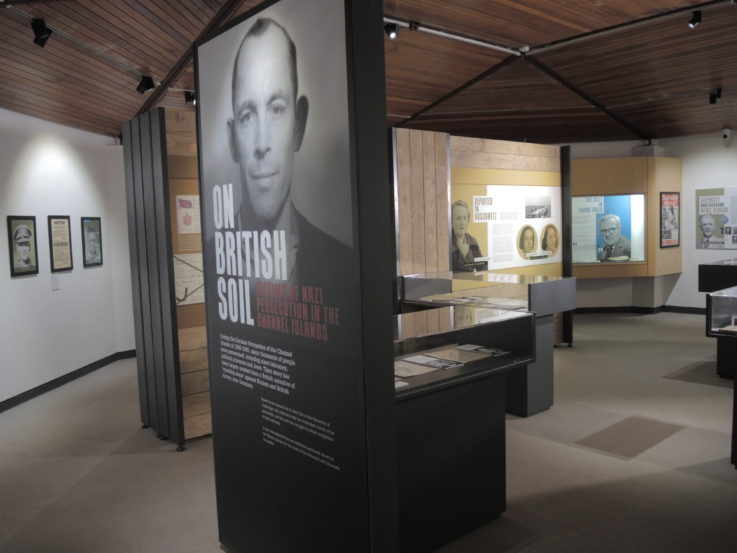
A powerful new exhibition has just opened at Guernsey Museum focusing on the stories of the Jews, political prisoners and forced labourers who were in the Channel Islands during the Occupation. Built on the research of Dr Gilly Carr (University of Cambridge) who has been researching this subject for the last decade, the exhibition brings together objects made in camps and prisons, archival records which document persecution, artefacts which tell a story of persecution, and accounts of the journeys of families to find the bodies of their relatives lost in the Nazi camp system.
This exhibition will allow clearer parallels to be drawn with Nazi persecution on the continent and shows how such persecution also happened on British soil. A special feature of the exhibition showcases this website, detailing the stories of c. 220 deported islanders, as well as clips from BBC documentaries on Sidney Ashcroft, Joseph Tierney and Joseph Gillingham, which detail how their bodies were found after being lost for 70 years. There are also two digitised recordings for visitors to listen to: Harold Le Druillenec speaking before the King’s speech in 1945, and Frank Falla being interviewed by the BBC in 1946, while he was attending a gathering of Europe’s Maquis in Belgium.
The exhibition is on until 12 May 2019.
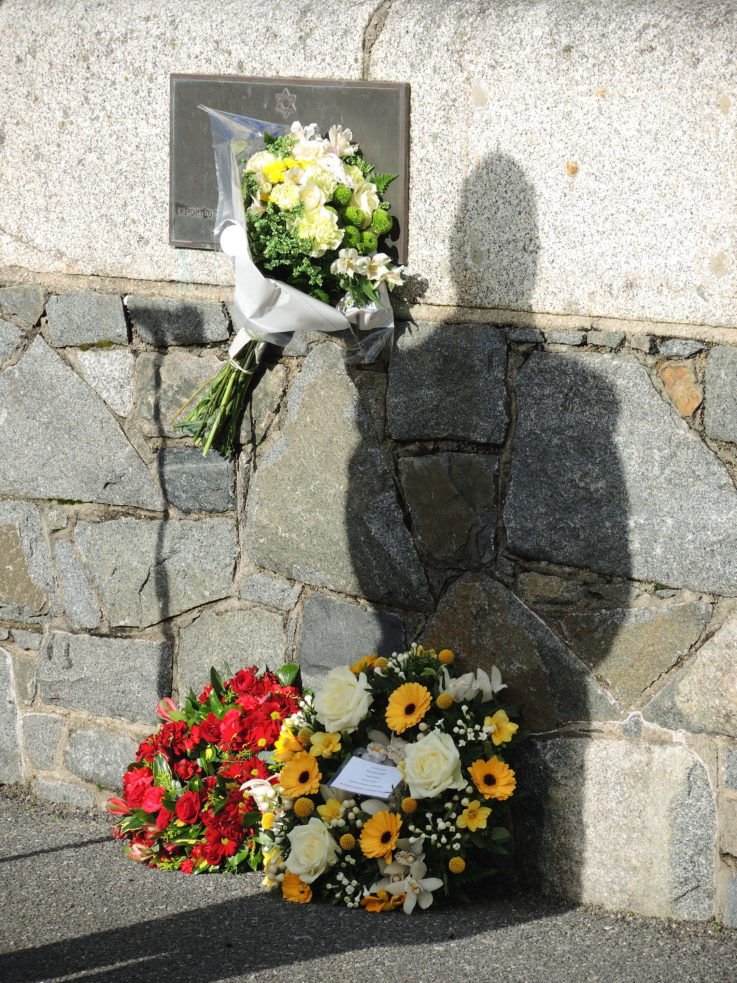
Holocaust Memorial Day 2019
This year the Frank Falla Archive attended Holocaust Memorial Day in Guernsey. Despite the icy winds, over 50 people attended the outdoor ceremony led by the Dean. The formula for the occasion was almost identical to last year: the Bailiff, Sir Richard Collas, laid wreaths at the memorials to the island’s forced labourers and resisters, and at the small bronze plaque dedicated to the memory of Marianne Grunfeld, Therese Steiner and Auguste Spitz. These three Jewish women were deported from Guernsey in April 1942 to France, from where they were rounded up three months later and deported to Auschwitz. After the ceremony, the crowd moved on to the town church, where a small preview of the forthcoming exhibition ‘On British Soil’ was on display.
In Jersey, HMD was marked, as usual, with a more extensive memorial indoor ceremony. Jenny LeCoat, screenwriter of Another Mother’s Son, the film of the story of Louisa Gould and Harold Le Druillenec, was this year’s guest speaker. The event was followed by an outdoor wreath laying at the Lighthouse Memorial to the Jersey 21. Here, numerous wreaths were laid by community leaders.
There is a marked difference between the ceremony in the two Islands. At Jersey’s, many more politicians and community leaders attend, and the event draws large crowds. Over the years, there have been speeches which acknowledge past wrongs with regards to the Jews of the island. In Guernsey, the event has been much smaller, except when it was held inside the town church in 2015-16. Speeches are not made and no Bailiff has yet to publicly address the Island’s failure to protect Jews or political prisoners during the Occupation. It is hoped that 2020, the 75th anniversary of the liberation of Auschwitz, might provide the occasion for such speeches.
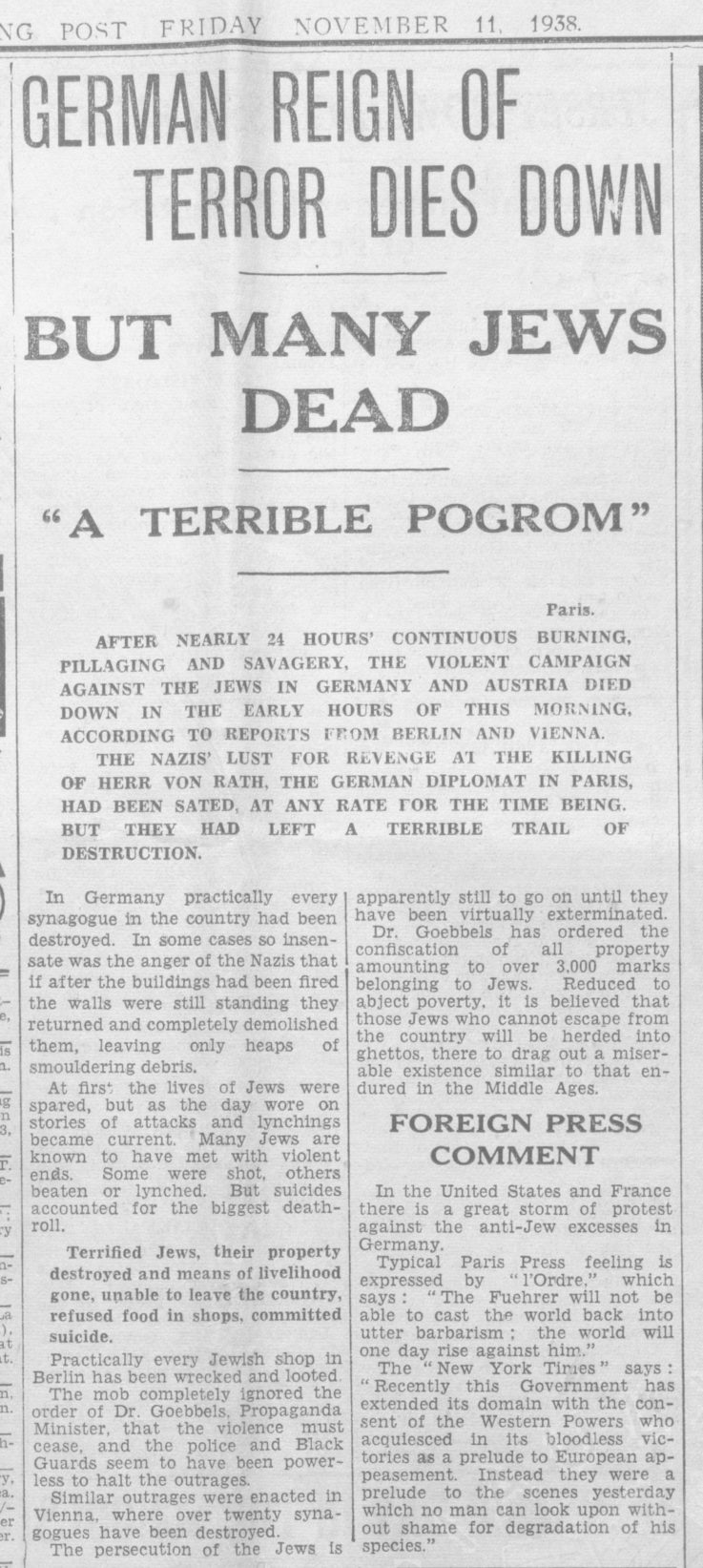
I have heard it asked in the Channel Islands whether, even if local people knew what the Nazi attitudes were towards the Jews, maybe they didn’t know about or hear about any antisemitic atrocities in advance of the Occupation. So, to commemorate the 80th anniversary of Kristallnacht, otherwise known as the Night of Broken Glass or the November Pogrom, I have added an article from the Jersey Evening Post for 11 November 1938 which reported on the events of 9-10 November in Germany and Austria. Very similar articles were published by the Guernsey Evening Press and the Guernsey Star. Reports continued to arrive over the following days and this was a live issue in the local newspapers during this period.
In advance of the German Occupation, many Jewish residents of the Channel Islands evacuated, but some stayed, mainly those without British nationality who were not permitted to travel, or those married to British citizens. Some British-born Jews also stayed in the Islands. We do not have a full list of Jews in the Channel Islands left behind during Occupation, but the number is thought to be between thirty and fifty. A small number of people with what might be considered Jewish surnames (such as Cohen) did not identify themselves or come forward to be registered as Jews during the Occupation.
In total, we know that three Jewish women without British citizenship (Therese Steiner, Auguste Spitz and Marianne Grunfeld) were deported to France and thence to Auschwitz in April 1942. They did not survive. We know that five Jews with British nationality and one without was deported to Compiegne transit and internment camp; of these, all survived the war, although the one without British nationality, John Finkelstein, was sent to Buchenwald Concentration Camp. Julia Brichta, a Hungarian woman who denied being – but was indeed – Jewish was deported from Guernsey to Ravensbrueck concentration camp for Black Market offences. She survived.
Two Jewish women, Hedwig Bercu and Mary Richardson, went into hiding in St Helier, capital town of Jersey. All Jews, regardless of British citizenship, were subject to antisemitic legislation and harassment in the Channel Islands during the Occupation.
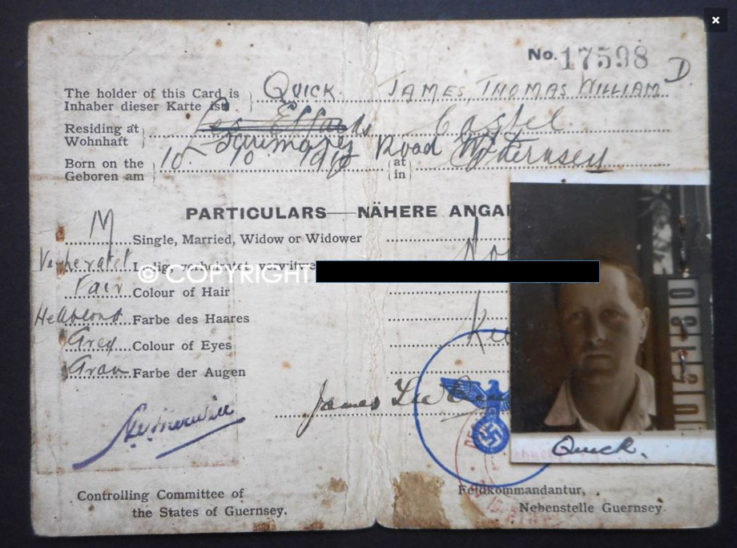
The Occupation identity card of Buchenwald survivor, Guernseyman James Quick, has been seen online by a member of the FFA team and recently purchased by Guernsey Archives. The website of the online militaria dealer has been removed from the photo shown here.
The Frank Falla Archive team are saddened to see such items separated from the families of the original owners and strongly urge families to either keep such items of family history or else to donate them to the Island Archives in Guernsey or Jersey Archives, as appropriate. While private collectors can, to a certain extent, act to ‘save’ such items from oblivion, at the same time the possession of such items in private hands means that they are not available for study by researchers. While some private collectors in the Channel Islands are happy to show their items to researchers, this is not the case for all, and in any case depends on the availability of the collector.
This identity card of James Quick will, we hope, now be displayed in a special exhibition coming to Guernsey Museum in March 2019. On British Soil: Victims of Nazism in the Channel Islands was on at the Wiener Library from October 2017 – February 2018 and will be travelling to Guernsey next. Quick was one of 9 Islanders in Buchenwald camp and their story will, we hope, be featured in the exhibition. James Quick’s story can be read here.
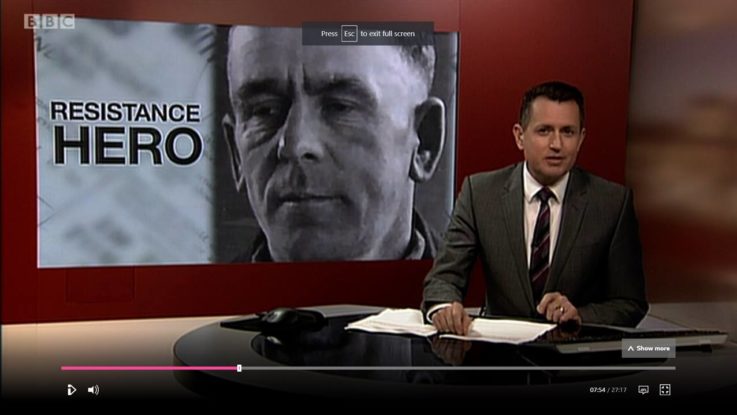
The Frank Falla Archive recently published the story of Guernseyman James Tardivel, who was deported for offending a German officer. He was sent to prison in France, and later transferred to Calais to work at a forced labour site. He escaped from there to join the French resistance.
Tardivel lay low some distance away from Calais, living with a French family. Once the Allies arrived, the Germans living locally fled, but 50 of them were rounded up. Tardivel was put on guard duty, but another group of Germans tried to free their comrades. Tardivel was hurt in the attack, suffering wounds to his body that put him in hospital. However, he recovered quickly and returned to Guernsey in July 1945. Before he left he was given a certificate to prove his resistance credentials.
The BBC is helping the Frank Falla Archive appeal for the relatives of Tardivel to come forwards. We’re hoping that they have that certificate, as well as Tardivel’s false identity card that he was given by the resistance. Tardivels everywhere, please get in touch with the Frank Falla Archive if you know anything. We’d love to display his certificate online.

On 25 and 26 September, the Frank Falla Archive teamed up with the Holocaust Educational Trust (HET)to give Holocaust education teacher training in Guernsey and Jersey. Workshops were held at Guernsey Grammar School and Jersey Arts Centre, and Martin Winstone of HET and Gilly Carr of the Frank Falla Archive spoke. In Jersey they were joined by Chris Addy of Jersey Heritage (JH), who told teachers about resources available from JH. The day comprised examples of classroom exercises, lesson plans and teaching material available from the HET website. Gilly Carr showed teachers the material available on the Frank Falla Archive website, and gave an introduction to Channel Islands-specific materials relating to the Jewish experience, the political prisoner experience, and the forced labourer experience.
The workshop in Jersey was filmed, and the resulting videos will be placed on the website within the section devoted to educational materials. Teachers are also encouraged to share their ideas for student exercises with the Frank Falla Archive so that a database can be built up for all Channel Islands’ teachers to share.
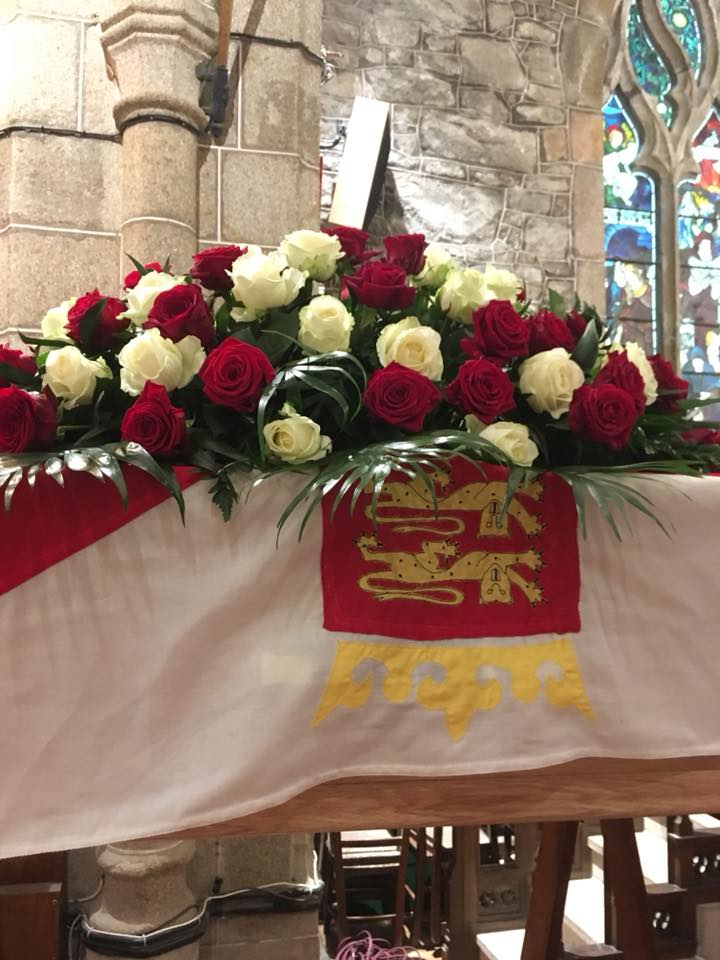
The memorial service for Frank Le Villio of the Jersey 21, newly repatriated to Jersey, was held today at St Saviour’s parish church. The service was led by the Rvd Peter Dyson, who gave an excellent address. Stanley Keiller, who found Frank’s unmarked grave in Nottingham, read the tribute. The moving service was filmed by the BBC and ITV and can be seen in these links.
Frank’s coffin, draped in a Jersey flag and crowned with a large bouquet of red and white roses, Jersey’s colours, was brought into the church; the service was attended by around 150 people. The occupation generation and members of other families of the Jersey 21 were represented among the congregation, as well as Frank’s relatives, the Constables of St Helier (Simon Crowcroft) and St Saviour (Sadie Rennard), and the Frank Falla Archive.
In his tribute, Stanley Keiller admitted that he felt ‘quietly and emotionally satisfied’ to have found Frank. ‘Welcome home, Frank – rest in peace’, were his closing words.
The service ended with the National Anthem, which was allowed to be played at the end of every church service during the Occupation. This was followed by ‘Beautiful Jersey‘ (more normally heard on Liberation Day) as the congregation filed out.
Frank will be reburied in Surville Cemetery in Jersey on 6 September 2018.
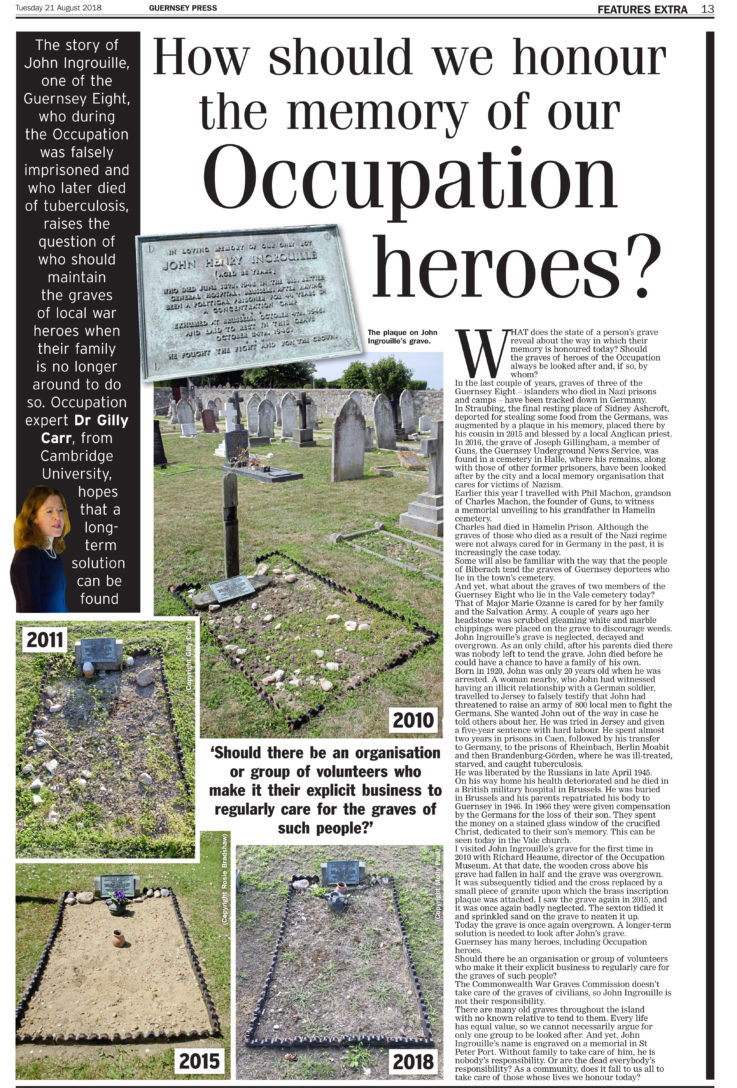
I’ve written an article for the Guernsey Press about the grave of John Ingrouille of the Guernsey Eight (now uploaded to his page). Upon learning recently that his grave was once again overgrown, I thought it important to draw attention to this to see if a more permanent solution could be found for its upkeep. John died aged only 25 after serving a sentence of five years hard labour after a local woman informed on him. She claimed that John said that he could raise an army of 800 men to fight the Germans. He was deported to Nazi prisons in Germany. His full story can be read on his page. John died of TB on his way home from a displaced persons camp. He was an only child and after his parents died there was nobody to tend his grave.
After discussing the state of his grave with others on social media, I decided to write an article for the Guernsey Press about it. Does the solution to this neglect lie in a special Island task force dedicated to tidying the graves of Occupation heroes? Or is all it requires a couple of bags of marble chips – or even a proper headstone? I hope that John’s grave can be rescued from neglect in the near future.
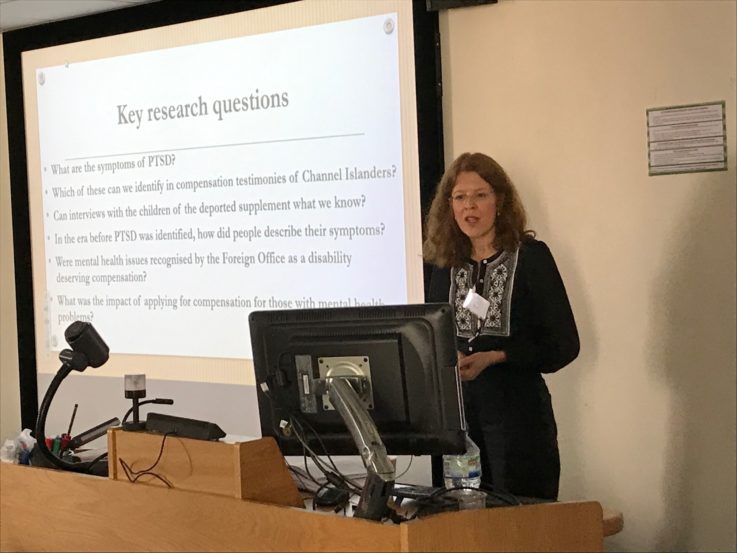
At the annual meeting of the British Association of Holocaust Studies, this year held at the University of Leeds, Gilly Carr gave a paper entitled ‘Detecting PTSD in the compensation testimonies of British victims of Nazi persecution from the Channel Islands’. In addition to drawing on compensation testimonies, Gilly used testimony from the children of victims of Nazism who spoke about their fathers’ experiences.
The term ‘PTSD’ was given to the condition only in 1980, although ‘concentration camp syndrome’ was recognised soon after the war. However, not all of the symptoms we list today as part of PTSD were recognised then, or in the 1960s, when the compensation testimonies were written.
In order to get compensation for impairment to health, the Foreign Office, who administered the claims, did not enquire about mental health conditions. Despite this, many islanders struggled with and mentioned a number of symptoms. Because the checklist of symptoms we know now was not known in the 1960s, we can only glimpse brief references to some of these, such as nightmares, flashbacks, angry outbursts, inability to work due to mental health problems, amnesia, insomnia, and avoidance of reminders of the original trauma. This led to men making statements such as ‘I was in Buchenwald and we all know what happened there’, or children recalling that their fathers wouldn’t eat certain foods that they ate in the camps, or men referring to their experience as ‘when I was in Germany’, but with no or little further detail.
The paper concluded that there was ample evidence that people showed symptoms of PTSD, but that we cannot tell whether they ticked every box that would be required for diagnosis today as they are no longer alive to interview. It also concluded that people were not compensated for symptoms of PTSD, only for physical disability, as the Foreign Office did not ask about mental health conditions and did not treat suffering applicants with any sympathy or understanding.
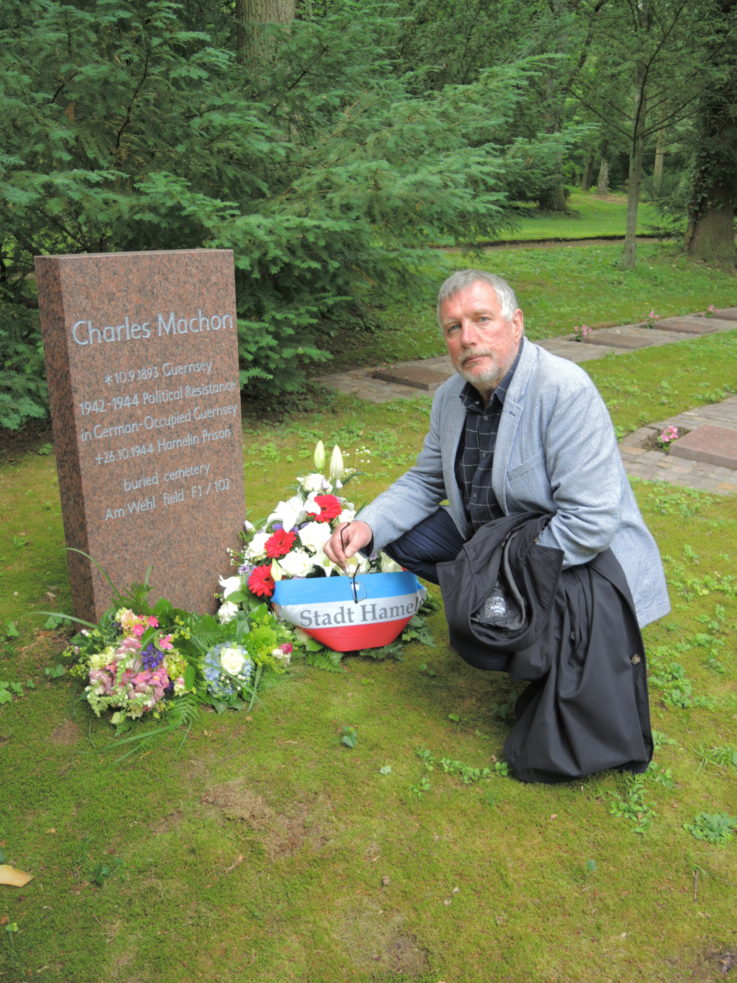
A memorial has been unveiled in Am Wehl cemetery, Hamelin, Germany, for Charles Machon, one of the Guernsey 8 and founder member of GUNS, the Guernsey Underground News Service.
In the presence of Charles’ grandson, Philip, his wife Diana Hill, Gilly Carr of the Frank Falla Archive, the Mayor of Hamelin, and members of a memory activist group for victims of Nazism in Hamelin led by local historian Bernhard Gelderblom, flowers were laid at the foot of the new memorial. The erection of the memorial was made possible by Gelderblom, who made a speech at the unveiling, along with Gilly Carr and Mayor Claudio Greise.
Charles Machon’s body still rests in a nearby grave, although this grave now belongs to another person given German customs governing the re-use of graves. Thus, the memorial is close by, near other victims of Nazism in the cemetery.
Machon died in Hamelin Zuchthaus (prison) in 1944. This building still stands but is today a four-star hotel. Signs of its former use are still visible.
The memorial ceremony was poignant, moving, and respectful, and the hosts in Hamelin could not have been more welcoming, kind, and helpful to us.
Charles Machon is now the seventh of the Guernsey 8 whose final resting place has been located and suitably marked. The body of Louis Symes, who died in Cherche-Midi prison in Paris, has yet to be located. Machon’s name can also be seen on the Resistance Memorial in St Peter Port in Guernsey.
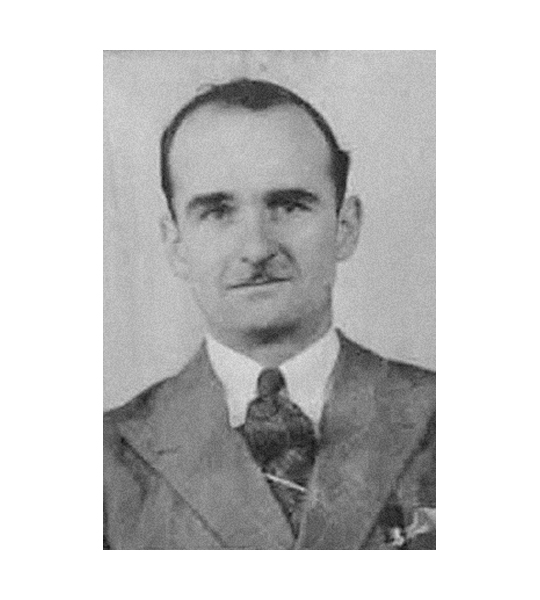
It is just possible that Gilly Carr of the Frank Falla Archive has uncovered the real identity of Peter Bruce Johnson of the Jersey 21.
Our knowledge of Peter Johnson stems only from the memory of a local historian, the late Joe Miere of Jersey, who met Johnson during the German Occupation. There were some key features about Johnson that stuck in Miere’s memory: he was Australian; his job was to saw timber; he was deaf and mute; and he was involved in an accident in which his thumb was cut off. There is one major flaw: no record of any sort has ever been found for someone of this name. Paul Sanders, historian and author of The Ultimate Sacrifice (about the Jersey 21), and Gilly Carr, have both reached the conclusion that Miere must have remembered Johnson’s name incorrectly. No person of that name had a Jersey registration card, and no person of that name has a record in the International Tracing Service, which both historians have searched. If Miere got the name wrong, were other details of the story wrong? Did he confuse the details of two people and conflate them into the one person of Peter Johnson?
Gilly Carr has recently been contacted by Joanne McAuliffe in Australia, grand-daughter of UK-born Thomas Patrick Nelson, a man deported from Jersey during the Occupation. However, her records clearly show that Nelson was living under an alias: his real name was Thomas Frederick John Nanson. Nanson lived a double life and, having returned to the UK after spending his formative years in Australia, he married his first wife. A few years later, after getting in trouble with the law, he came to Jersey under a new name, perhaps to escape a turbulent past, a failed marriage, and even a criminal conviction.
Nanson / Nelson claimed to have been born in Australia. He was deaf, having lost his hearing while serving in the Royal Artillery in the 1920s. His job at the time of his deportation was sawing wood. However, he appeared to have all fingers and thumbs intact and there is no memory in his family that he had any impaired digits. However, one of his prison records indicates that he had multiple marks on his hands and fore-arms, which is consistent with an accident with a timber-cutting machine.
Nanson / Nelson was deported to Saint-Lo Prison, and then Fort de Villeneuve-Saint-Georges. Crucially, after his release by American forces in the summer of 1944, he was repatriated to the UK and did not return to Jersey. Instead, he returned to Australia in 1945. Was he like Walter Dauny, a member of the Jersey 21 who was found to have survived the war after being liberated from Villeneuve-Saint-Georges Prison? Was he instead the man that Joe Miere remembered as Peter Bruce Johnson, who is assumed (on very scanty evidence) to have died in Dora-Mittelbau concentration camp?
The truth is that we will probably never know. While good records survive for Thomas Nanson / Nelson, nothing at all survives for Peter Johnson. We have nothing to compare Nanson / Nelson’s story to other than Joe Miere’s memory. While the names of the two men differ (although their surnames are similar), their jobs were the same, both had a connection with Australia, and – crucially – Nanson / Nelson was deaf, just like Johnson. Were they the same man or is Nanson / Nelson’s possession of all fingers and thumbs enough to rule him out? What do you think?
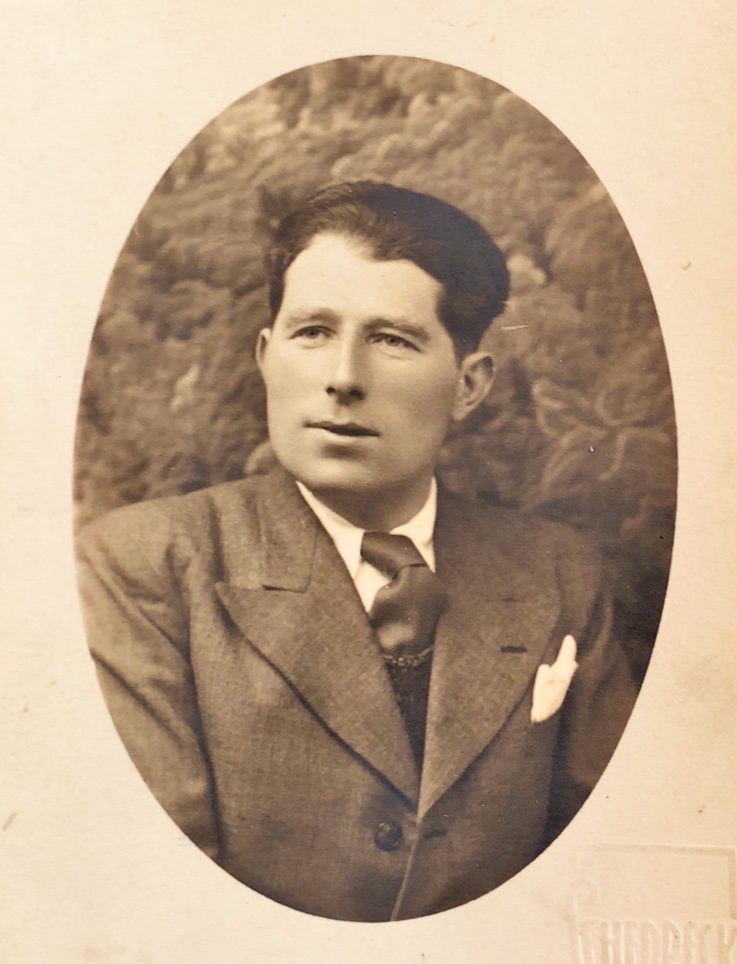
9 May: Pierre Salomon found!
Announcement made formally by the Jersey Evening Post.
Pierre Salomon was born on 13 July in 1905 in the parish of Trinity to French nationals, Pierre and Marie Salomon, who married and settled down in Jersey before Pierre was born.
The Salomons had four children, but while three of them had British citizenship, Pierre Salomon junior retained French nationality and left Jersey, aged 34, to join the French army at the outbreak of World War II. However, after the German invasion and capitulation of France, soldiers in the French army were taken prisoner of war. Pierre was among them. No trace of Pierre was found after the war, despite his family searching for decades.
Earlier this year, I visited the Wiener Library in London which has digitised copies of records from the International Tracing Service (ITS) in Bad Arolsen in Germany. This archive contains all surviving records of German concentration camps, prisons and labour camps. It was here that I found Pierre Salomon.
Records from the ITS revealed that Pierre had died in hospital of typhoid fever (a disease caused by contaminated food or water) on 19 June 1944. He had been based at Falkensee Camp, a sub-camp of Sachsenhausen Concentration Camp, on the outskirts of Berlin. He had carried out forced labour in the Siemens-Schuckert armaments factory. He had been buried (presumably in a mass grave) in Berlin-Frohnau cemetery. He had also been in other camps in the Berlin area for the previous two years.
Prisoners of war – especially those who were not of officer status – were often used by the Germans as forced labour. At what point did this happen to Pierre? Was Pierre Salomon an ‘ordinary’ French forced labourer, or did his surname, which the Germans might have assumed indicated Jewish heritage, mean that he was selected for worse treatment in Jewish camps? More research is needed.
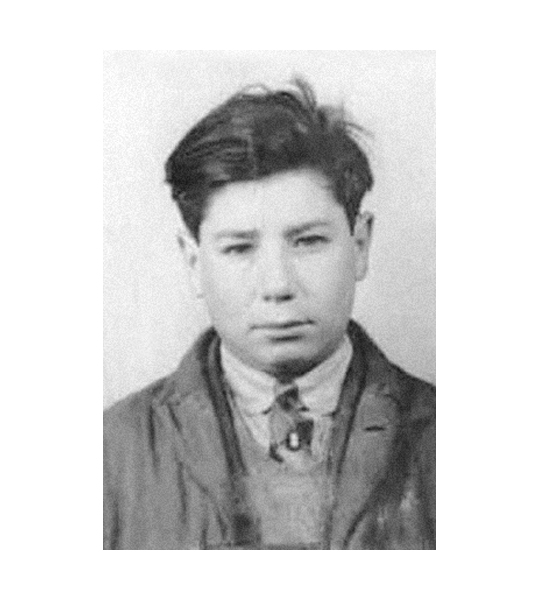
9 May: Frankie Le Villio is coming home.
I’m sure that most people in the Channel Islands have heard the good news that the body of Frankie Le Villio of the Jersey 21 is to be exhumed from his pauper’s grave in Nottingham and repatriated to Jersey for reburial in the summer of 2018. This has been delayed while the money has been raised, but now things can move forward. Please watch this page for news, as the Frank Falla Archive plan to be there to witness the reburial. In fact, the Frank Falla Archive will be busy in the coming month; in June we will be in Hameln, Germany, to see a memorial unveiled in honour of Charles Machon of the Guernsey Eight. We are also on the trail of the newly discovered Pierre Salomon from Jersey, discovered in March 2018 to have died in a labour camp in Berlin.
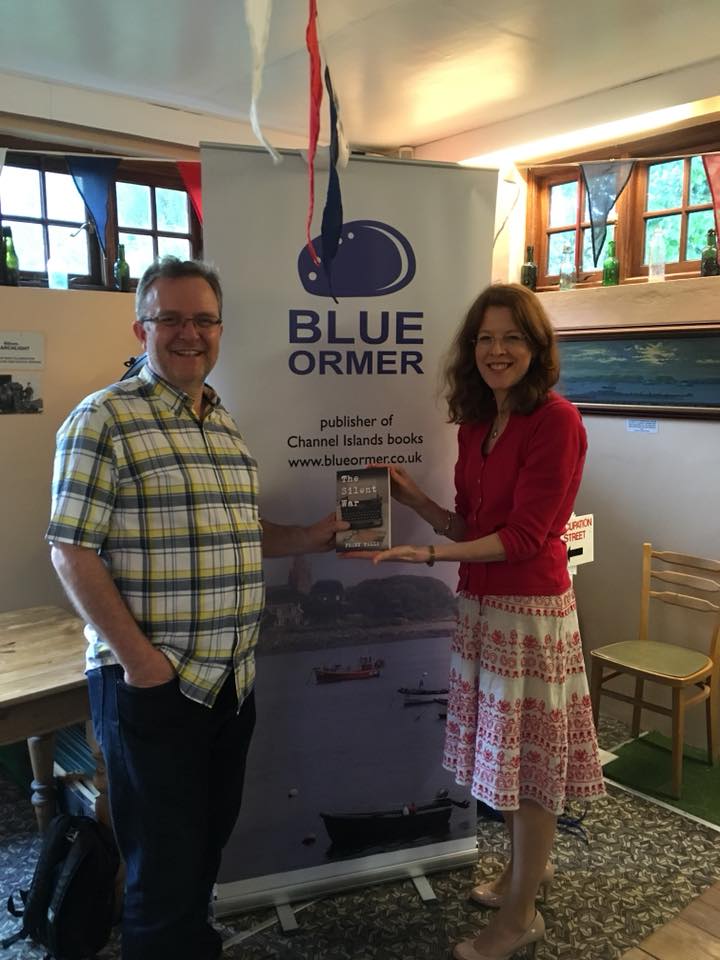
6 May 2018: The Silent War
The third edition of Frank Falla’s The Silent War was launched at the German Occupation Museum, Guernsey, hosted by Richard Heaume, the owner and director.
I was delighted to have been asked by Steve Foote (pictured here on the left) of Blue Ormer Publishing to write the foreword to the new edition and to give a short speech at the launch.
The event went well and there was enough prosecco and Guernsey gache for all! Even better, I met Matthew Tostevin, who gave me two new names for the Frank Falla Archive: brothers Victor and Hilary Gontier, his grandfather and great-uncle. Keep your eyes peeled for their stories coming soon!
Meanwhile, if anyone wants to buy a copy of the new volume, you can do so via this link for Blue Ormer Publishing.
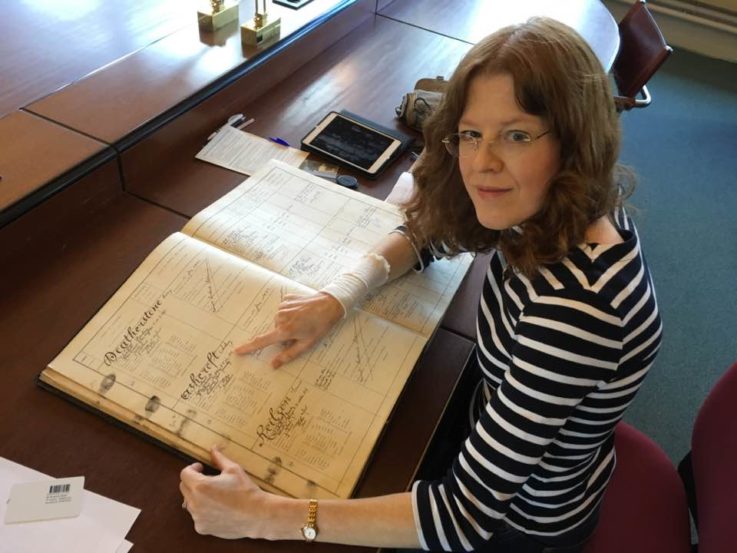
Caen, Lisieux and Coutances Prisons – news just in
19 April 2018: The Frank Falla Archive team (Gilly Carr and Rod Miller) have just returned from Caen (and, for Rod, St-Lo as well) where we went to collect the prison records. We expected to find 52 names in Caen Prison; instead we found 62. Although ten of these were Organisation Todt workers, the remaining 52 were not the 52 we were expecting: many were new and 21 of those who we thought we knew were there were not present. We discovered that there was a second prison in Caen: Beaulieu Prison, just up the road from the Maison d’Arret. 11 members of the deported Guernsey Police were, we assume, in Beaulieu (and 5 in the Maison d’Arret), as were 6 of those deported for sheltering commandos in Guernsey in November 1940. We still don’t yet know what dictated who got put in which prison.
The good news is that we found the names of another three Islanders in Caen who were not in the Frank Falla Archive before (Paula Pemberton and Harold Dodd from Guernsey, and Amelia Bree from Jersey). To that we can add the name of Brian Le Boutillier from Jersey, who was in Lisieux Prison (the records were also at Caen), and Henry Palmer from Lisieux. Every name rescued is a little victory! The grand total of people on the Frank Falla Archive list now stands at 212.
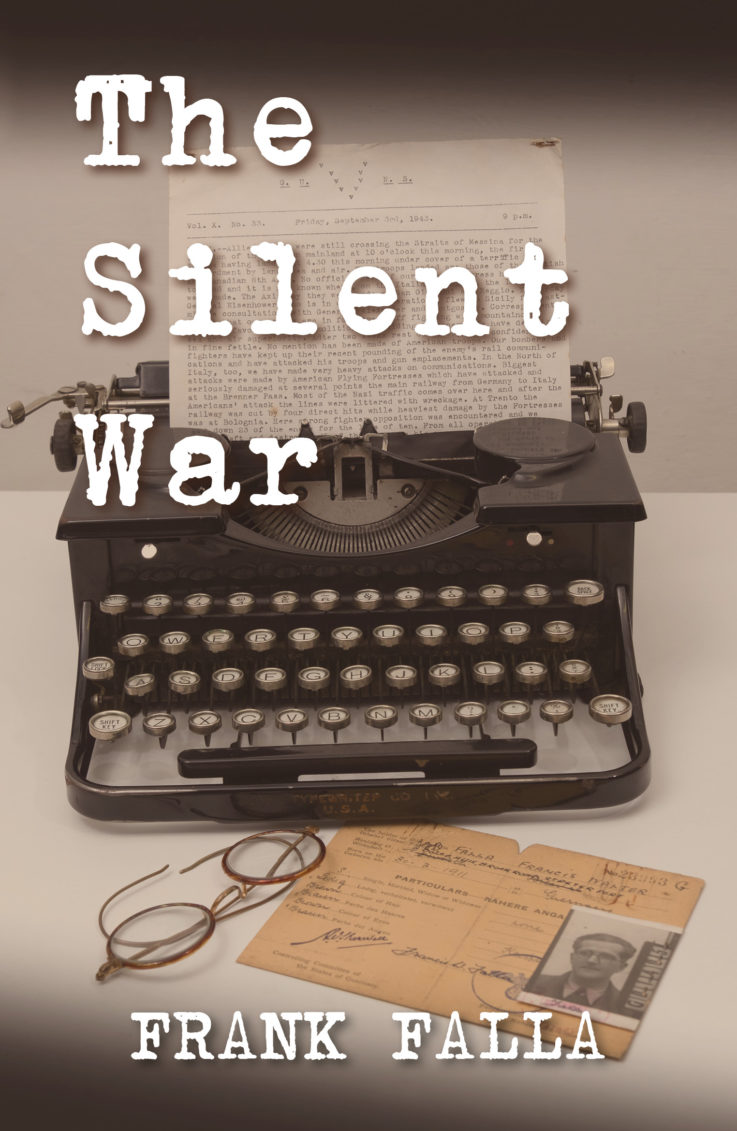
The new edition of The Silent War by Frank Falla is now ready to order online. This new edition has a new foreword by me (Dr Gilly Carr), which discusses Falla’s legacy and the Frank Falla Archive website. It also has many new images from Frank Falla’s personal archive (now lodged at Guernsey Archives) to better reflect the book’s focus on victims of Nazism, including images of the new Resistance Memorial and GUNS plaque in St Peter Port.
The book is £8.99 and can be pre-ordered through Blue Ormer Publishing here.
The book will also be available to purchase for the first time on 21 April 2018 at a special event scheduled as part of Guernsey’s Heritage Festival, where Gilly Carr will be speaking on the topic of ‘Resisters: Heroes or Villains of the Occupation?‘. This event starts at 2.30pm at the OGH Hotel in St Peter Port and includes a sumptuous afternoon tea. Advance booking is necessary and can be done here.

Forthcoming lecture
I’m giving a lecture at the Old Government House Hotel in Guernsey on 21 April at 2.30pm as part of the Heritage Festival. My title is ‘Resisters: Heroes or Villains of the Occupation?’
You can book tickets here:
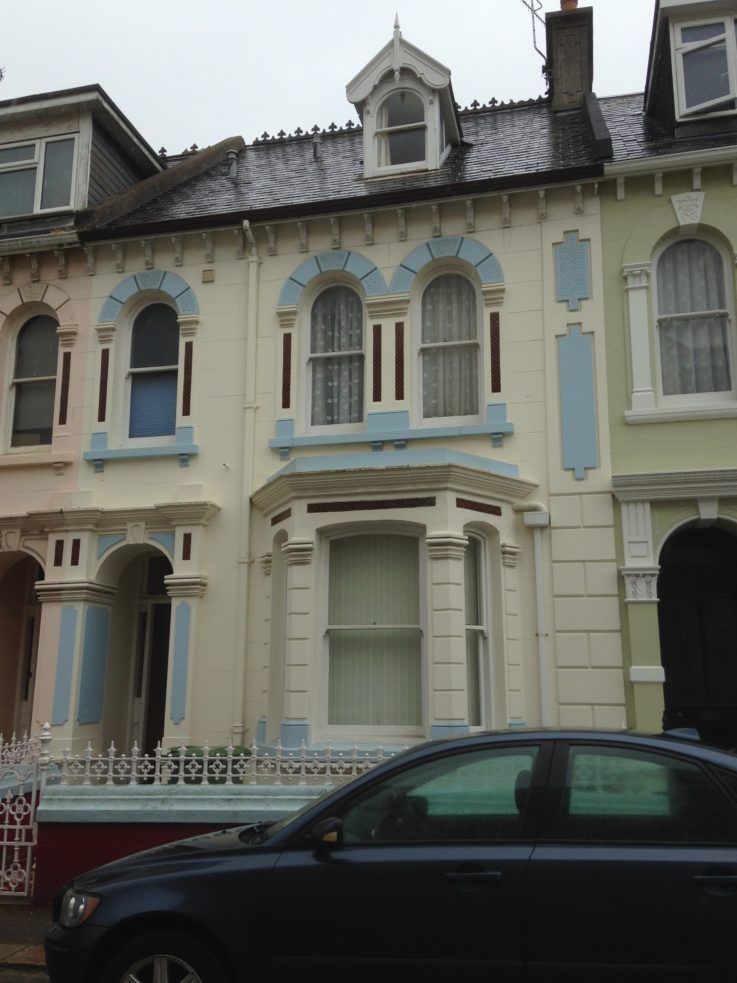
Did Albert Bedane alone shelter Mary Richardson?
26 March 2018: I’ve written a new article for the Jersey Evening Post asking whether there’s a possibility that more Jews were hidden in St Helier during the Occupation. This suggestion is based on information published in the 1982 memoir by Dr John Lewis (‘A Doctor’s Occupation’). It has never yet been ascertained whether information about the Jewish woman in question and those who hid her was deliberately changed to protect identities, or whether the information given was entirely accurate. If it was accurate, the details provided are almost enough to identify those concerned – IF the relevant documents still exist. In the article I ask John Lewis’ children or grandchildren to contact me if they still possess Lewis’ medical day book. This holds the key. Of course, there are ethical and legal considerations to take into account with such documents, but official guidance will be taken to make sure that all research meets official requirements. Meanwhile we must ask ourselves: was a third Jewish woman hidden in St Helier, and can this case finally be cracked?
10 April 2018 update: I’ve been in touch with Dr Lewis’ son who tells me that his father’s medical day book no longer exists. However, I discovered from a woman who interviewed Dr Lewis that the Jewish woman in question went into hiding on Roseville Street, which means that it is almost certain that it was Mary Richardson, who we know was sheltered by Albert Bedane. However, she went into hiding with Bedane in the summer of 1943 and Dr Lewis said that she vanished in September 1942. There are some inconsistencies with the archival record here, but the most troubling is his statement that she was hidden by an ‘elderly couple’. Did Albert Bedane share the responsibility of hiding her?

Dorothea Le Brocq (British Hero of the Holocaust) update
23 March 2018: Here at the Frank Falla Archive, we have received word from Pierre Landick, second cousin of Dorothea Weber nee Le Brocq, that he has had a memorial plaque put up in Worthing Cemetery to honour Dorothea’s memory. Dorothea sheltered Jewish woman Hedwig Bercu in her home in St Helier, Jersey, during the German Occupation. For this brave act, Dorothea was declared Righteous Among the Nations at a ceremony in Jersey in November 2016, and named as a British Hero of the Holocaust at a ceremony at the Foreign and Commonwealth Office in January 2018.
Dorothea died in 1993 and her ashes were scattered at Worthing Cemetery. She was not honoured in her lifetime; rather, she seems to have been ostracised by her family and others in Jersey. She had three strikes against her name: Dorothea was illegitimate; she married an Austrian baker, Anton Weber, in 1941 who was later drafted into the German army, which made Dorothea a ‘jerrybag’ – a local term of abuse for women who consorted with German soldiers. After Weber was declared missing presumed dead, she married a British liberating soldier in 1945 who turned out to have committed bigamy. Dorothea, too, was charged with bigamy when Anton Weber returned to Jersey to look for her.
Now that the whole story is known, we can recognise Dorothea for the brave woman that she truly was. Although her memory was not preserved within her own family, her second cousin, Pierre Landick, who learned of her existence only in 2016, holds her memory in high esteem. He and his family have had a memorial plaque erected in her honour, with Dorothea’s name inscribed ‘in loving memory’.
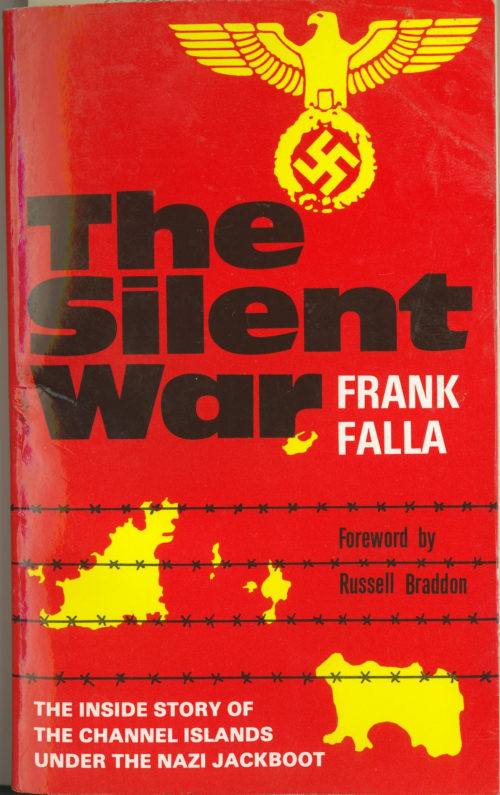
March 2018: I have been working with Frank Falla’s two children over the last few weeks in securing a publisher for a reprint of The Silent War. We’re pleased to announce that Blue Ormer Publishing, run by Stephen Foote, a Guernseyman based in London, will be reprinting the book.
Originally published in 1967, The Silent War details the story of the people involved in GUNS (the Guernsey Underground News Service), which operated from May 1942 to February 1944. It also tells the story of the five men (including Falla) deported to Nazi prisons for their role. What makes this book important is that it is one of precious few memoirs, published or unpublished, of islanders deported to Nazi prisons and concentration camps. In fact, we can count the entire corpus of such books on the fingers of one hand.
What is particularly important about Falla’s work is its legacy. Thanks to him, at least fifty Channel Islanders received compensation as victims of Nazi persecution in 1965. Around 100 applied. Thanks to his archive, now currently split between Guernsey Archives and my office at the University of Cambridge (but eventually to be reunited in Guernsey Archives), many clues have been left behind which enabled the location and presence of islanders in various Nazi institutions to be recorded. Better still, these clues were sufficient for me to eventually be able to find, in 2016, the grave of Falla’s GUNS colleague, Joseph Gillingham. Visiting that grave in Halle for the first time, with Gillingham’s daughter, will always stand out to me as one of the most unforgettable moments of my life.
Thus it is fitting, at a time when Falla’s legacy is being newly recognised, just over 50 years since its first publication with Leslie Frewin, that it will once more be back in print. The new version will include extra photos from the Frank Falla Archive, as well as new images. The book is scheduled to come out in time for Liberation Day (May 9) 2018. Watch this space for information on how to pre-order the book!
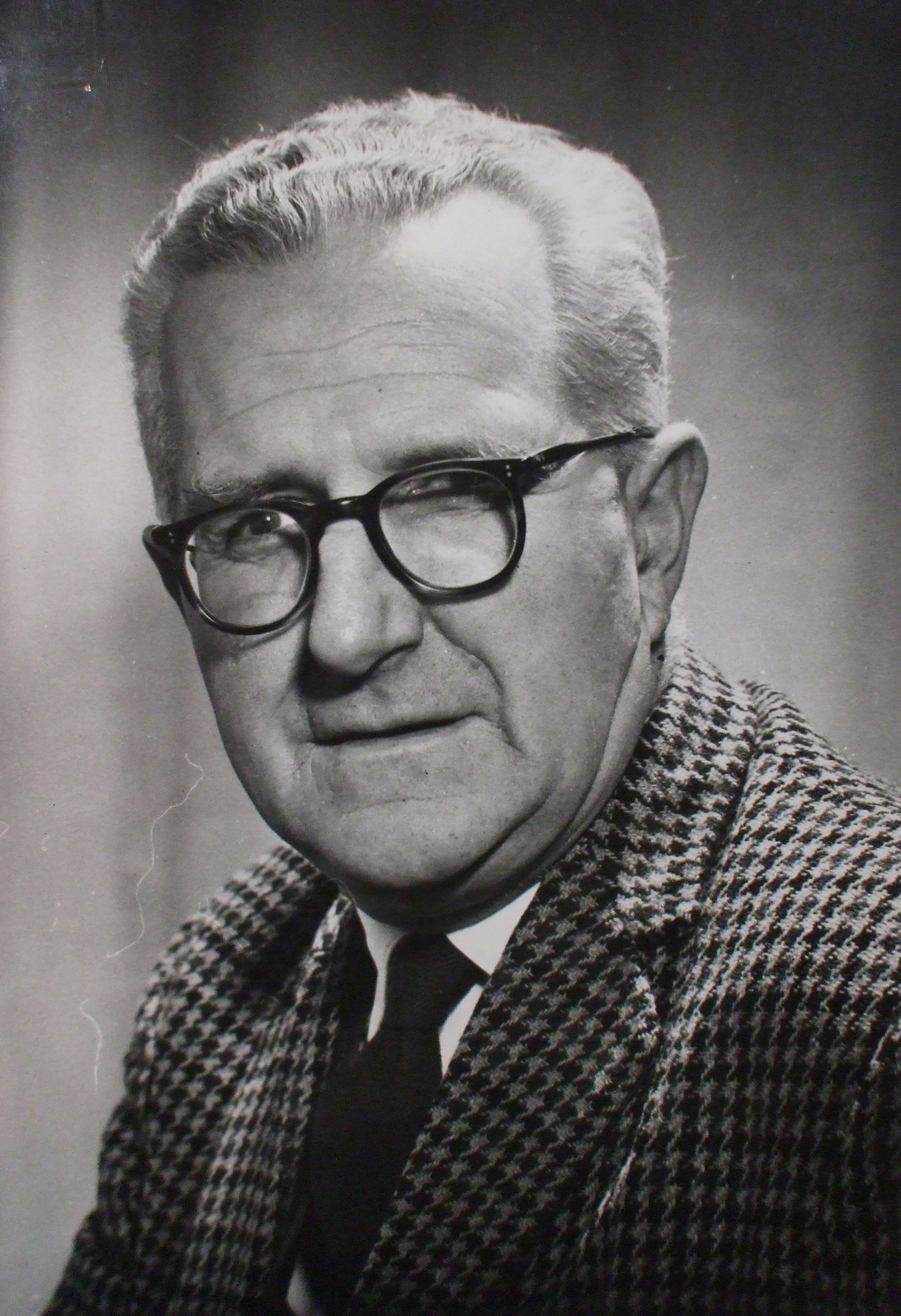
On 2 February 2018 the BBC published a special feature about Frank Falla, which can be read here.
They focus on the role of Frank Falla in lobbying the Foreign Office to fight for compensation for Channel Islanders. They in particular look at the fight made on behalf of Roy Machon and Bill Quin. Both of these men suffered in Nazi camps and for different reasons the Foreign Office would not compensate either. As Machon was the only Brit in his prison, there was nobody else who could testify that he was there. The FO also had no information about the kind of prison it was, but alleged that it was not a severe enough place to warrant compensation. Machon, who was made deaf through the head injuries he sustained at the hands of guards, would have to live with this result.
Quin, on the other hand, had PTSD which manifested itself such that he could not remember a thing about his experience – he had blacked it out. Falla visited him on several occasions and managed to extract enough fragments from him to persuade the FO to give him compensation. However, it was only in 2018, when assessing the experience of William Cordrey from Jersey, was it possible to use Falla’s fragments to find out where Quin had been. Thus, Falla’s tireless work is still yielding dividends today.
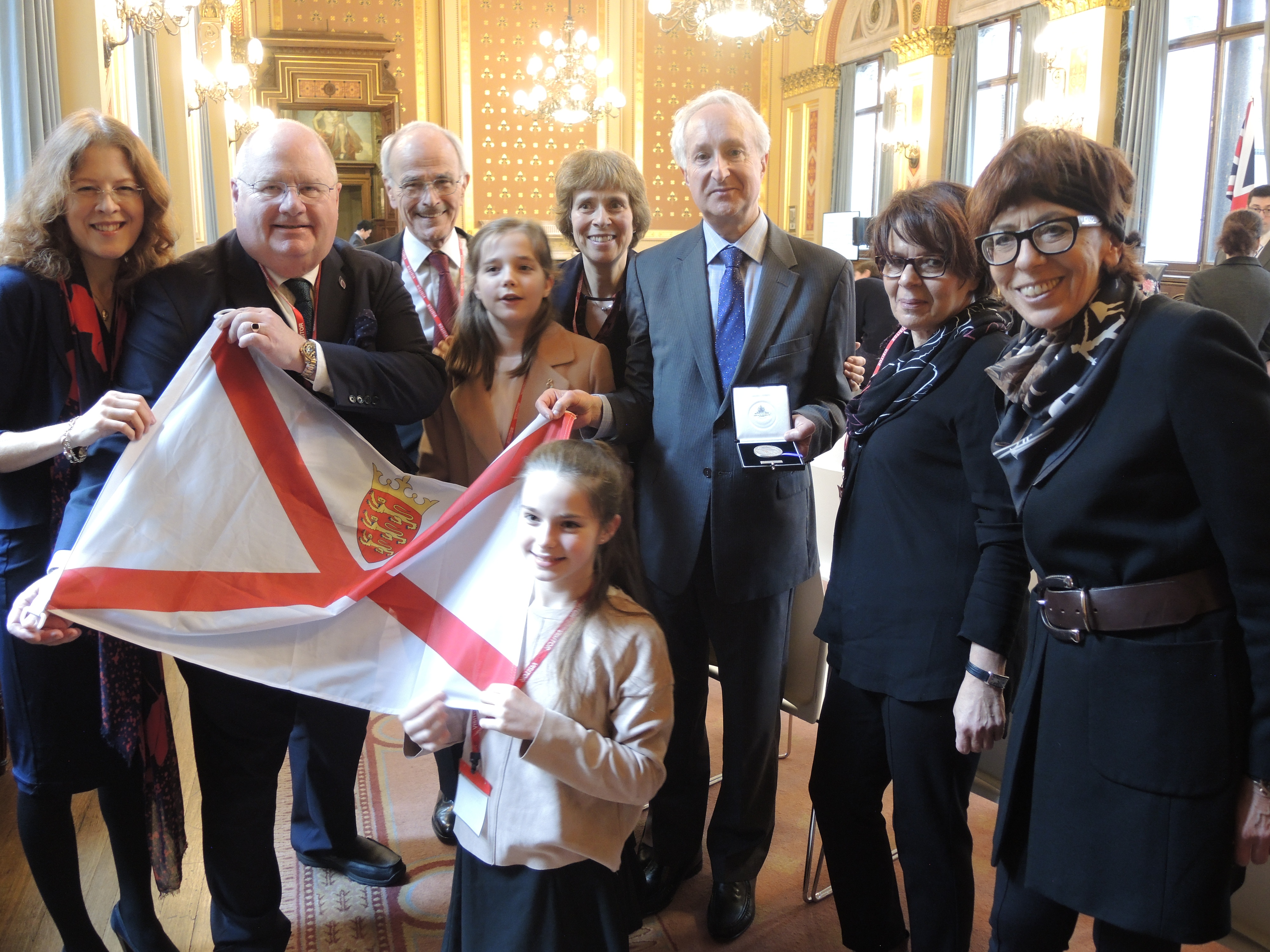
On January 23 2018, the Foreign and Commonwealth Office in London held its Holocaust Memorial Day ceremony. The event was also used as an occasion to honour a new crop of recipients of British Heroes of the Holocaust.
One of six people honoured was Jerseywoman Dorothea Le Brocq, who sheltered Jewish woman Hedy Bercu for 18 months during the Occupation. Dorothea had been made Righteous Among the Nations by Yad Vashem in November 2016, so this occasion marked the second award that she has now received postumously.
Dorothea’s second cousin Pierre Landick received the award on her behalf. Also present to witness the ceremony was Pierre’s sister and brother in law and their two daughters. Hedwig’s two daughters, Marion and Elizabeth, also flew to London to witness the occasion. Samuel Gibbs from the Government of Jersey in London office attended, as did Dr Gilly Carr from Cambridge University, who submitted the application for the award.
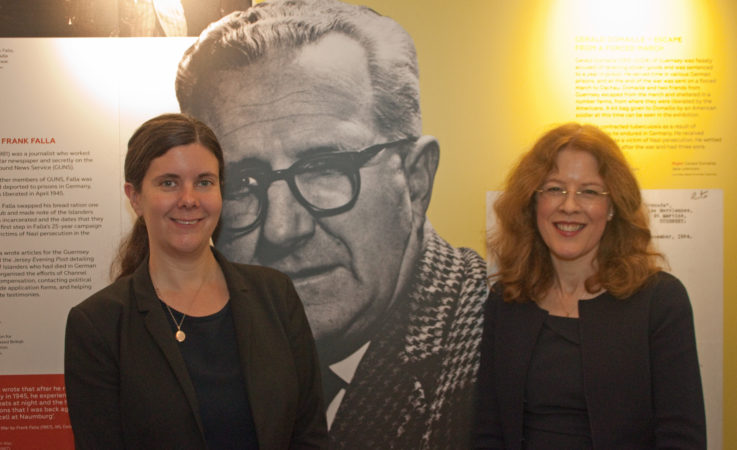
From October 2017 to February 2018, the exhibition ‘On British Soil: Nazi Persecution in the Channel Islands’ was on at the Wiener Library in London. The exhibition was co-curated by Dr Gilly Carr (University of Cambridge) and Dr Barbara Warnock (the Wiener Library).
The exhibition presented the stories of various groups: the Channel Islands’ Jews, the forced labourers and the political prisoners, following the experiences of various key people. It also examined the work and legacy of Frank Falla, the 1965 compensation claims, and the memorialisation of victims in the Channel Islands.
The exhibition was opened by Sir Philip Bailhache, former Bailiff of Jersey, who did so much to promote the memory of victims of Nazism. Alice Allen, a Jersey poet now living in London, read some of her work. Gilly Carr also gave a speech. The family members of several Channel Islander victims of Nazism also attended to support the exhibition and to view the items that they had lent be put on display.
The exhibition was accompanied by special events and lectures.
Now that the exhibition has finished, an online version has been created.

A new exhibition at the Wiener Library for the study of the Holocaust and Genocide is due to open on 19 October. ‘On British Soil: Nazi Persecution in the Channel Islands‘ is co-curated by Dr Gilly Carr of the University of Cambridge.
During the German occupation of the Channel Islands (1940–1945), many thousands of people were persecuted, including slave labourers, political prisoners and Jews. Their story has been largely omitted from a British narrative of ‘standing alone’ against Nazism and celebrations of British victory over Germany.
This exhibition tells the stories of these persecuted, drawing upon The Wiener Library’s rich archival collections, files recently released by The National Archives, and items belonging to the victims of Nazi persecution themselves.
From the experiences of a young Jewish woman living quietly on a farm in Guernsey and later deported to Auschwitz, to those of a Spanish forced labourer in Alderney, and the story of a man from Guernsey whose death in a German prison camp remained unknown to his family for over 70 years, this exhibition highlights the lives of the persecuted, and the post-war struggle to obtain recognition of their suffering.
The Frank Falla Archive website will go live in time for the launch of the exhibition on 19 October.
The exhibition is supported by a Heritage Lottery Fund grant.
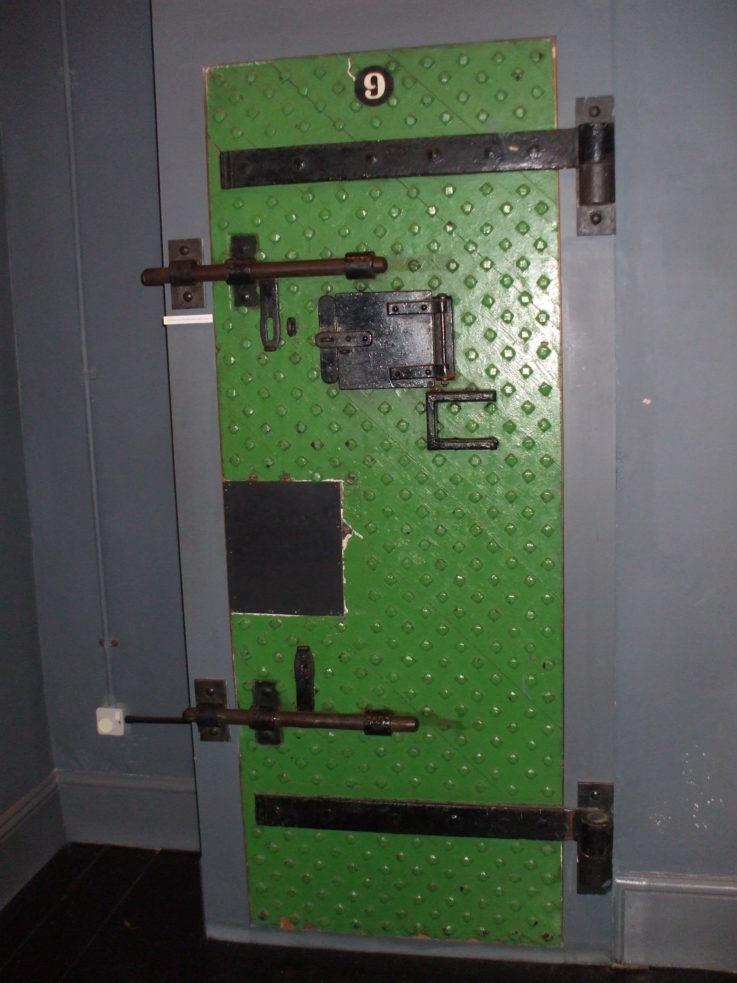
October 2017: Ethics and prisoner stories
Ethics are an important consideration for presenting prisoner stories online. My aim for this website is to make known what has been silenced and not spoken about for over 70 years. I also strongly believe that it is important to acknowledge the suffering of the deported in their prisons and camps and thereby to honour them. It is not right to close our eyes to human suffering. For too long, those who were deported for acts of opposition to the occupiers, or who committed an offence at a time when most aspects of daily life were becoming illegal, have been condemned as ‘foolish criminals’. I believe that this is not only wrong but offensive to the memory of those who stood up to Nazism. Even where people were deported for offences that history has condemned as less honourable, it is important to state that a sentence in a Nazi prison or camp rarely – if ever – fitted the crime.
The treatment of some Channel Islanders was brutal, and where the entry contains particularly distressing information, I have added a warning at the start. In this way, teachers using the material online for educational purposes can be guided over whose stories to avoid recommending to younger children. The warning also serves to prepare families for what has been discovered about their loved ones. I have also, over the last few years, made great efforts to contact families of Channel Islander victims of Nazism and to ask permission to put online testimonies and family documents. Where families have not yet got in touch with me, I welcome their contact so that we can honour their family members properly.
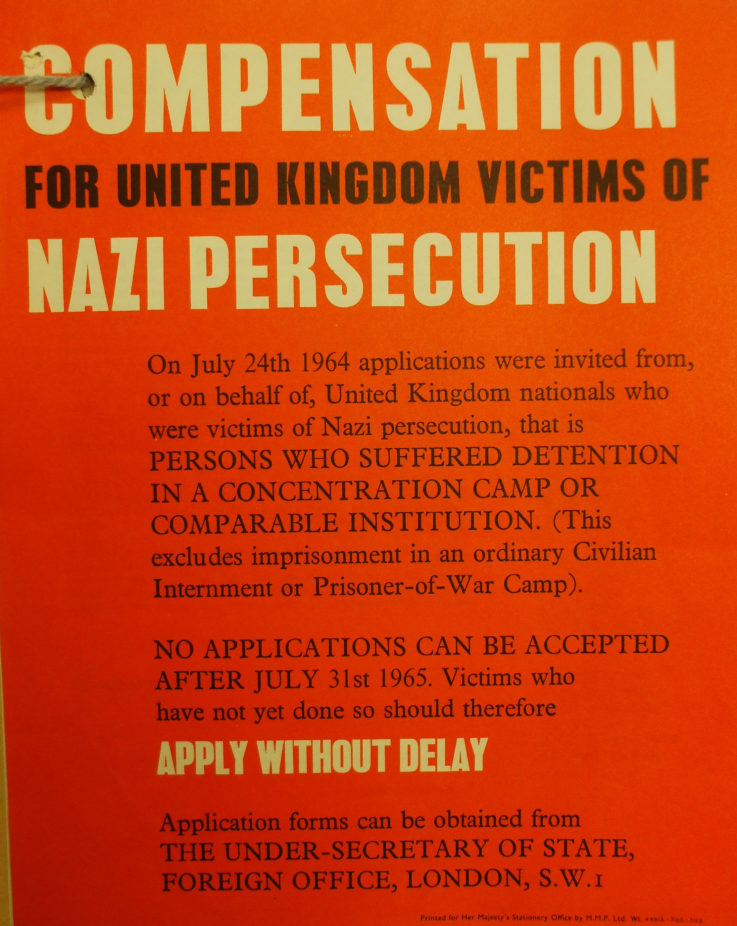
August 2017: How do you write a prisoner’s story?
The most important starting place when beginning to write the profile of one of the deported islanders is their occupation registration or identity cards. This gives me their photo, their address, their date of birth and their job. A full name and date of birth is the magic information that I need in order to search for their presence in a Nazi prison or concentration in Germany or further afield. I do this via the International Tracing Service at the Wiener Library in London. Anybody can make an appointment to search the ITS records on their computers. Unfortunately the records are not so good for French prisons. Searching the ITS records is a slow business and you’d be surprised how many people in Europe had the same or similar names in Nazi prisons and camps, which is why date of birth is so important to identify people. In a single day working on ITS records, I consider myself lucky if I collect the records of ten people. As I say, it’s a slow business!
The next stage is to search for the court martial records, of which Jersey has a fuller set than Guernsey. Fortunately, Jersey’s are now digitised and can be searched for online through their catalogue, which is a massive help to me when I’m sitting in Cambridge! When I have dates for the court records and find out what the person in question was convicted of and when (and often who they were convicted with, which gives us an idea about small resistance groups), I then consult Jersey’s political prisoner log book, an invaluable resource as it tells me who from the island was deported, and when. Guernsey’s equivalent book appears not to have survived, but I have faith that it is out there somewhere. By this stage, I am able to build a picture of what the person did to be deported, and hopefully, with the help of ITS records, I may even know where they were sent. The key question I need to know then is what the experience was like for them, so I will then turn to the compensation testimonies written in the 1960s. Almost half of all of those deported to Nazi prisons and camps wrote one of these so, if I’m lucky, then I will have the information waiting for me. Some people wrote pages of testimony and others simply listed which prisons they were sent to and when, which is rather disappointing for me. In general, the better educated the person was, the more they wrote and the more eloquent they were. However, Post Traumatic Stress Disorder (PTSD) often got in the way of this. If they were badly affected, they often could not bear to write much about what happened to them, or their memories might have been badly affected, especially if they had sustained head injuries in the camps. Beatings and ill-treatment was common, and so were medical problems which lasted a life-time for those affected.
I will then also read the profile of the camp or prison concerned, which has been written by my colleague Rod Miller, also working on the project. I cannot praise him highly enough for the work that he has done! To learn about the conditions of the prison or camp will be of great interest to families who had family members there.
Sometimes I am lucky and the family of the person deported has contacted me with memoirs, diaries, prison letters and similar archival records, and this means that I can learn a great deal more about the person. This also means that their memory is preserved for posterity if it can be placed online and disseminated more widely. It also means that others can learn about what Channel Islanders experienced in prisons and camps. This is not just a story about what happened to those on the continent. It affected Britons too. So if you’re reading this and you have archives that you are willing for a researcher to photograph for this website, please get in touch!
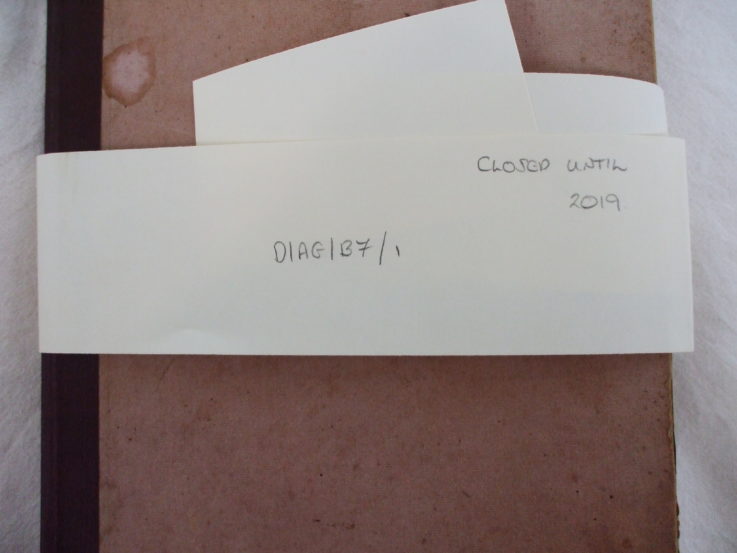
10 August 2017: How does the Frank Falla Archive find names?
Compiling the list of names of deported Channel Islanders has been undertaken from scratch as there was no roll of honour available. The late Joe Mière, a former political prisoner from Jersey, had compiled his own list, but as many of these people were sent only to internment camps, it is not a reliable list for what we were looking for with the Frank Falla Archive. In addition, I want every name to come from a verifiable archival source, so I started from the beginning.
The first source I began with was the political prisoner log book for Jersey prison, as this recorded all those who were deported from Jersey (and a few people from Guernsey who were sent to Jersey before deportation). This was not a fool-proof source because it also listed people who came to Jersey during the occupation (such as people who worked for the Organisation Todt), and so every name needed to be scrutinised and double-checked.
As the Guernsey counterpart of this log book has not yet been located, we cannot know who from Guernsey was deported, and this is a problem as it means that we can be much more sure about Jersey names compared to Guernsey, and also means that our list of people deported from Jersey is longer, which may or may not be an accurate reflection of who was really sent away.
We can also add the names of ‘known’ people from Guernsey who were deported, such as the 16 policemen convicted for stealing food from German stores; the five men deported for their role in the Guernsey Underground News Service; and the 16 members of families deported for sheltering the two commandos, Hubert Nicolle and Jimmy Symes. This immediately nets us 37 people. After that it was a matter of adding locally ‘known’ figures, such as the three Jewish women (Therese Steiner, Auguste Spitz and Marianne Grunfeld) deported to France in April 1942; Winifred Green sent to Caen Prison for cheekily saying ‘Heil Churchill’ when asked to say ‘Heil Hitler’; or Xavier de Guillebon who was also sent to Caen Prison for chalking up V-signs. After I added names known from memoirs, the next big source was those who wrote a testimony in the mid-1960s to claim compensation for being a victim of Nazism. I went through the list of over 4,000 people from the UK who submitted a claim and picked out Channel Islander surnames and other English names that I recognised. After this process, things became harder. I was then a matter of finding references in prison correspondence to other islanders in prison. I also made a list from police copies of court martial records from both Guernsey and Jersey of everybody who had a sentence of longer than three months. Not all of these people would have been deported, but many of them were. My research colleague on the project, Rod Miller, was sent to France to go through prison records from places such as Caen Prison and Fort de Villeneuve-Saint-Georges, where many islanders were sent, to see if he could find any new names.
I also published many articles in the Guernsey Press and Jersey Evening Post asking people to come forwards if their family members were deported. I have also consulted the International Tracing Service records at the Wiener Library in London and checked out the prison and concentration camp records of islanders. Sometimes on the same page of the prison record of one person, another islander is named. Collecting names from Guernsey is a slower process as the records are not online.
We will never know when we have the full list of names. At the time of writing, we have around 205 names, and I feel confident that we are 95% there. If anyone reading list has a new name for me, please get in touch!
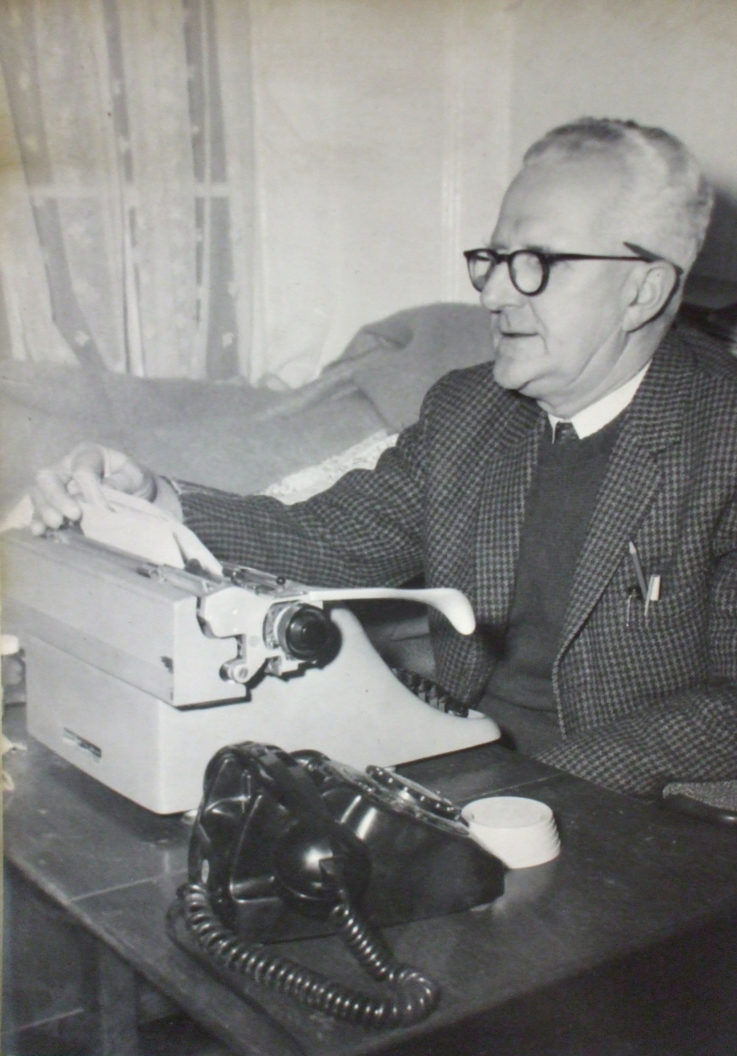
August 2017: The Frank Falla Archive: who is this website about?
Welcome to the Frank Falla Archive, the website that aims to encapsulate the experience after deportation of all Channel Islanders sent to Nazi prisons and camps. Deciding who to include and who not to include is not as straight-forward as you might think. In 2014 I estimated that between 200 and 250 Islanders were likely to have been deported to these locations. This number was based on known names plus estimates based on the length of prison sentences (records of not all of which survive) and likelihood of deportation. At the time of writing (August 2017), this upper number has not yet materialised and, with so many French Archives missing or destroyed, we are unlikely to ever reach the true figure. However, I suspect that the number presented in this website is not too far off the final figure. For those from Jersey who are familiar with the figure of 300 quoted by the late Joe Mière, it is important to be clear that Joe and I are counting slightly different things. I made the decision not to include those sent to civilian internment camps, even for acts of resistance, while Joe included these numbers. This is because the experiences in Biberach, Wurzach, Laufen, and Liebenau (etc) are much well documented and these camps were far more humane than that of Nazi prisons and concentration camps. I am also including only those who were in the Channel Islands at the outbreak of the occupation who were deported, so my figures do not include members of the Organisation Todt who came to the Channel Islands during the occupation, even if their court records are mingled with those of islanders. One cannot always tell who was here before the occupation as not all occupation registration cards survive, and many aliens records are closed, missing or destroyed in Guernsey and Jersey. This means that of course I include Jews deported during the occupation, but only those sent to Nazi prisons and camps. I also include foreign nationals who lived in the Channel Islands before the Germans arrived, whether they were English, French, Dutch or another nationality, although discovering when they arrived is not always easy.
I have also taken the decision to include those from Guernsey and Jersey who were deported to Alderney. Although this is still within the Channel Islands, these people were still deported and includes the names of people still well known in the islands for their ordeal there.
It is entirely possible that, at the end of the project, we will still be missing some people. This is why I need the help of families of those affected. I invite you to contact me to let me know what information and family documents you have: photos, stories, records, memoirs, diaries … I’d like to see it all! Please get in touch with me by clicking on the ‘contact us’ tab.